Static and Seismic Responses of Eco-Friendly Buried Concrete Pipes with Various Dosages of Fly Ash
Abstract
:1. Introduction
- ➢
- A robust 3D finite element model is developed for evaluating the optimal displacement of GPC pipes by utilizing fault displacement (static loading) and records of the actual earthquake (seismic loading) as well as traffic loads and self-weight of soil and GPC pipe as live and dead loads in this study;
- ➢
- The possibility of relative comparison of seismic and static responses of buried pipes under the influence of GPC properties is developed in this field;
- ➢
- The utilization of element types of solid 185 and pipe 288 compatible with the proposed nonlinear model such as Drucker–Prager has been applied for the first time in this study after validating with similar element types such as solid 65 used in previous investigations.
2. Finite Element Modeling
2.1. Determination of Basic Equations for the Stress–Strain Curve of GPC
| Proposed Model | Constitutive Models Equation for GPC Concrete | ||
|---|---|---|---|
| Modified Popovics function, (Isojeh et al. [22]) | < 1.0 → k = 1 | [Equation (1)] [Equation (2)] | |
| Modifed Popovics function (Halahla [23]) | |||
| Popovics [24] | N = 0.058 f’c + 1 | N/A | |
| Fan et al. [19] | n = 4 | N/A | |
| Popovics [25] and Mander et al. [26] | |||
| EN 1992-1-1 [27] | N/A |
Validation of the Developed Constitutive Model for GPC Concrete
2.2. Model Validation
- -
- Shear transfer coefficients for an open crack (βt);
- -
- Shear transfer coefficients for a closed crack (βc);
- -
- Uniaxial tensile cracking stress (ft);
- -
- Uniaxial crushing stress (positive) (fcu);
- -
- Biaxial crushing stress (positive) (fcb);
- -
- Ambient hydrostatic stress state (σha);
- -
- Biaxial crushing stress (positive) (f1);
- -
- Uniaxial crushing stress (positive) (f2);
- -
- Stiffness multiplier for cracked tensile condition (Tc).
2.3. Material Properties of Soil and GPC in FE Modeling
2.3.1. Selection of GPC Pipe Size
2.3.2. Selection of Element Type for GPC Pipe
- ➢
- The mesh size chosen for the pipe 288 is 0.5 m, as it is observed that this value gives better convergence in the nonlinear analysis compared to other mesh sizes examined in the study;
- ➢
- In addition, it is assumed that the pipe 288 element has no slip along the z-axis. So, the following route in FE ANSYS Mechanical APDL has been taken in this regard: Main Menu >> Preprocessor >> Numbering Ctrls >> Coupling/Ceqn >> Couple DOF;
- ➢
- The contact element is considered to define the fault in the middle part of the GPC underground pipe as fault displacement has been applied as one of the static loadings in this study. These contact elements are shown as the number of 16 CONTA175 and TARGE170 elements in the list of element types.
3. Static and Seismic Loading
3.1. Static Loading
- P = 50,000 lbs = 222,411 N;
- A = 2 × 1.5 = 3 m;
- Pressure (Live load) = 74,137 Pa (N/m2).
3.2. Seismic Loading
3.3. Determination of the Critical Node for Evaluating the Displacement of GPC Buried Pipe under Applied Loads
4. Boundary Condition
5. Discussion about Optimal Mesh Size of GPC Pipe
- ➢
- The elements with the mesh sizes of 1, 075, 0.5, and 0.25 m are used for FE analysis of the model including two soil types and the GPC pipe with a length of 7.6 m;
- ➢
- It is observed that the numerical results of 0.5 m and 0.25 m are obtained without significant variations compared to those of 1 m and 0.75 m. The convergence analysis for identifying the proper mesh size is the most important method to reduce the error related to the achieved force and displacement results in FE as the FE model with a fine mesh makes the numerical calculations more accurate compared to a coarse mesh. On the other hand, Weck and Nottebaum [48] discussed that it is predictable that the errors with a higher number of elements in the FE model need to converge nearly to zero. Accordingly, the numerical results in the relation to displacement and force have high accuracy with the enhancement of element numbers in FE models [48,49]. Thus, the mesh size of 0.5 including 3725 elements has been chosen for the FEM of the GPC pipe model. In addition, the numbers corresponding to the material properties defined in ANSYS are given in Table 10.
6. Static and Seismic Analysis
6.1. Static Analysis of GPC Underground Pipe
6.2. Dynamic Analysis of GPC Underground Pipe
- All linear and nonlinear properties of geometric material and linear and nonlinear elements are applicable. Young’s modulus and density are the minimum properties of the material to be determined.
- The first loading in the transient dynamic analysis (time history) is typically performed to provide the initial conditions governing the model in a very short time. Subsequently, the settings subjected to the main loading are to be conducted in continuation of the first solution.
- The effects of temporal integration must be active in transient dynamic analyses with damping effects or inertial loads. Otherwise, the problem is solved in static mode. This option is commonly active by default in the ANSYS software.
- The effect of stress stiffening is typically active by default, except that the following two cases can be inactive:
- ➢
- Dynamic analysis is performed in a linear state;
- ➢
- It should be ensured that the structure is not in the range of its buckling load and does not suffer from buckling due to the applied load.
6.3. The Response of GPC Pipe under Seismic Loadings for Critical State
7. Summary and Conclusions
- ➢
- The numerical results of the static analysis demonstrate that the highest value of displacement occurs in the middle of the GPC in which traffic load and fault displacement were utilized as the two types of static loads in this study. The output of numerical results indicated that the dosage of FA in the range of 10–30% has a key role in the improvement of the optimal displacement in static analysis.
- ➢
- As regards the time-history analysis, based on the displacement records from two distinctive actual earthquakes (Tabas, Iran in 1979; Friuli, Italy in 1981), it was proved that the inclusion of FA in the GPC pipe has a significant role in the improvement of the vertical displacement in the underground model compared to horizontal displacement as it was observed in the static analysis as well.
- ➢
- In conclusion, it would appear that the role of FA on the improvement of the vertical response of the GPC pipe under seismic loading with high acceleration is more visible compared to the other earthquakes with low acceleration.
- ➢
- The concrete properties of the GPC pipe for linear and nonlinear behavior of the GPC pipe are based on the findings experimentally obtained in this study, such as compressive strength, density, and other parameters numerically validated in this field.
- ➢
- The trench simulated in the ANSYS platform is composed of stiff clay for bedding and sidefill soil along with silty clay for backfill soil.
Author Contributions
Funding
Institutional Review Board Statement
Informed Consent Statement
Data Availability Statement
Conflicts of Interest
References
- Ghafoori, N.; Najimi, M.; Diawara, H.; Islam, M. Effects of class F fly ash on sulfate resistance of Type V Portland cement concretes under continuous and interrupted sulfate exposures. Constr. Build. Mater. 2015, 78, 85–91. [Google Scholar] [CrossRef]
- Shehab, H.K.; Eisa, A.; Wahba, A. Mechanical properties of fly ash based geopolymer concrete with full and partial cement replacement. Constr. Build. Mater. 2016, 126, 560–565. [Google Scholar] [CrossRef]
- Tee, K.F.; Mostofizadeh, S. Numerical and experimental investigation of concrete with various dosages of fly ash. AIMS Mater. Sci. 2021, 8, 587–607. [Google Scholar] [CrossRef]
- Mostofizadeh, S.; Tee, K.F. Utilization of Nonlinear Model for Finite Element Analysis of Reinforced Fly Ash Concrete Cubes and Beams. In Proceedings of the 40th Cement and Concrete Science Conference, Sheffield, UK, 31 August–4 September 2020. [Google Scholar]
- Tee, K.F.; Agba, I.F.; Samad, A.A.A. Experimental and Numerical Study of Green Concrete. Int. J. Forensic Eng. 2019, 4, 238–254. [Google Scholar] [CrossRef]
- Gharehbaghi, K.; Tee, K.F.; Gharehbaghi, S. Review of geopolymer concrete: A structural integrity evaluation. Int. J. Forensic Eng. 2021, 5, 59. [Google Scholar] [CrossRef]
- Tee, K.F.; Mostofizadeh, S. A Mini Review on Properties of Portland Cement Concrete with Geopolymer Materials as Partial or Entire Replacement. Infrastructures 2021, 6, 26. [Google Scholar] [CrossRef]
- Alzabeebee, S.; Chapman, D.N.; Faramarzi, A. A comparative study of the response of buried pipes under static and moving loads. Transp. Geotech. 2018, 15, 39–46. [Google Scholar] [CrossRef]
- Mohamedzein, Y.E.-A.; Al-Aghbari, M.Y. Experimental study of the performance of plastic pipes buried in dune sand. Int. J. Geotech. Eng. 2016, 10, 236–245. [Google Scholar] [CrossRef]
- Ebenuwa, A.U.; Tee, K.F. Reliability estimation of buried steel pipes subjected to seismic effect. Transp. Geotech. 2019, 20, 100242. [Google Scholar] [CrossRef]
- Chaallal, O.; Arockiasamy, M.; Godat, A. Field Test Performance of Buried Flexible Pipes under Live Truck Loads. J. Perform. Constr. Facil. 2015, 29, 04014124. [Google Scholar] [CrossRef]
- Rakitin, B.; Ming, X. Centrifuge Modeling of Large Diameter Underground Pipes Subjected to Heavy Traffic Loads. Bulletin of South Ural State University series. Constr. Eng. Archit. 2016, 16, 31–46. [Google Scholar]
- MacDougall, K.; Hoult, N.A.; Moore, I.D. Measured load capacity of buried reinforced concrete pipes. ACI Struct. J. 2016, 113, 63–73. [Google Scholar] [CrossRef] [Green Version]
- Lay, G.; Brachman, R. Full-scale physical testing of a buried reinforced concrete pipe under axle load. Can. Geotech. J. 2014, 51, 394–408. [Google Scholar] [CrossRef]
- McGrath, T.J.; DelloRusso, S.J.; Boynton, J. Performance of Thermoplastic Culvert Pipe Under Highway Vehicle Loading. In Proceedings of the Pipeline Division Specialty Conference, Cleveland, OH, USA, 4–7 August 2002. [Google Scholar]
- Li, Y.; Song, G.; Cai, J. Mechanical Response Analysis of Airport Flexible Pavement above Underground Infrastructure under Moving Wheel Load. Geotech. Geol. Eng. 2017, 35, 2269–2275. [Google Scholar] [CrossRef]
- Neya, B.N.; Ardeshir, M.A.; Delavar, A.A.; Bakhsh, M.Z.R. Three-Dimensional Analysis of Buried Steel Pipes under Moving Loads. Open J. Geol. 2017, 7, 1–11. [Google Scholar] [CrossRef] [Green Version]
- Tee, K.F.; Wordu, A.H. Burst strength analysis of pressurized steel pipelines with corrosion and gouge defects. Eng. Fail. Anal. 2020, 108, 104347. [Google Scholar] [CrossRef]
- Fan, K.; Li, D.; Damrongwiriyanupap, N.; Li, L.-Y. Compressive stress-strain relationship for fly ash concrete under thermal steady state. Cem. Concr. Compos. 2019, 104, 103371. [Google Scholar] [CrossRef]
- Nath, P.; Sarker, P. Flexural strength and elastic modulus of ambient-cured blended low-calcium fly ash geopolymer concrete. Constr. Build. Mater. 2017, 130, 22–31. [Google Scholar] [CrossRef] [Green Version]
- Waqas, R.M.; Butt, F.; Zhu, X.; Jiang, T.; Tufail, R.F. A Comprehensive Study on the Factors Affecting the Workability and Mechanical Properties of Ambient Cured Fly Ash and Slag Based Geopolymer Concrete. Appl. Sci. 2021, 11, 8722. [Google Scholar] [CrossRef]
- Isojeh, B.; El-Zeghayar, M.; Vecchio, F.J. Simplified Constitutive Model for Fatigue Behavior of Concrete in Compression. J. Mater. Civ. Eng. 2017, 29, 04017028. [Google Scholar] [CrossRef] [Green Version]
- Halahla, A.M. Identification of Crack in Reinforced Concrete Beam Subjected to Static Load Using Non-linear Finite Element Analysis. Civ. Eng. J. 2019, 5, 1631–1646. [Google Scholar] [CrossRef] [Green Version]
- Popovics, S. A numerical approach to the complete stress-strain curve of concrete. Cem. Concr. Res. 1973, 3, 583–599. [Google Scholar] [CrossRef]
- Popovics, S. A review of stress-strain relationships for concrete. ACI J. 1970, 67, 243–248. [Google Scholar]
- Mander, J.B.; Priestley, M.J.N.; Park, R. Theoretical Stress-Strain Model for Confined Concrete. J. Struct. Eng. 1988, 114, 1804–1826. [Google Scholar] [CrossRef] [Green Version]
- EN 1992-1-1 (2004): Eurocode 2: Design of Concrete Structures—Part 1-1: General Rules and Rules for Buildings. Available online: https://www.phd.eng.br/wp-content/uploads/2015/12/en.1992.1.1.2004.pdf (accessed on 21 October 2021).
- Zamanian, S. Probabilistic Performance Assessment of Deteriorating Buried Concrete Sewer Pipes. Master’s Thesis, The Ohio State University, Columbus, OH, USA, 2016. [Google Scholar]
- ANSYS Inc. ANSYS User Manuals Released 13.0; ANSYS Inc.: Canonsburg, PA, USA, 2010. [Google Scholar]
- Kwan, A.; Dai, H.; Cheung, Y. Non-Linear Seismic Response of Reinforced Concrete slit shear walls. J. Sound Vib. 1999, 226, 701–718. [Google Scholar] [CrossRef]
- Terec, L.; Bugnariu, T.; Păstrav, M. Nonlinear analysis of reinforced concrete frames strengthened with infilled walls. Rom. J. Mater. 2010, 40, 214–221. [Google Scholar]
- Kachlakev, D.; Miller, T.; Yim, S. Finite Element Modeling of Reinforced Concrete Structures Strengthened with FRP Laminates; Oregon Department of Transport: Salem, OR, USA, 2001. [Google Scholar]
- Badiger, N.S.; Malipatil, K.M. Parametric Study on Reinforced Concrete Beam using ANSYS. Civ. Environ. Res. 2014, 6, 88–94. [Google Scholar]
- Mostofizadeh, S.; Tee, K.F. Evaluation of Impact of Fly Ash on the Improvement on Type II Concrete Strength. In Proceedings of the 39th Cement and Concrete Science Conference, Bath, UK, 9–10 September 2019; pp. 190–193. [Google Scholar]
- ACPA (American Concrete Pipe Association). Concrete Pipe and Box Culvert Installation Design Manual; American Concrete Pipe Association: Irving, TX, USA, 2007. [Google Scholar]
- Lee, H. Finite Element Analysis of a Buried Pipeline. Master’s Thesis, University of Manchester, Manchester, UK, 2010. [Google Scholar]
- Nath, P. The effect of traffic loading on buried pipes. In Soil-Structure Interaction: Numerical Analysis and Modelling; John, W.B., Ed.; E & FN Spon: London, UK, 1994. [Google Scholar]
- Moore, I.D.; Hoult, N.A.; MacDougall, K. Establishment of Appropriate Guidelines for Use of the Direct and Indirect Design Methods for Reinforced Concrete Pipe; AASHTO Standing Committee on Highways: Washington, DC, USA, 2014. [Google Scholar]
- Wang, L.R.L.; Raymond, C.Y.F. Seismic design criteria for buried pipelines. In Pipelines in Adverse Environments—A State of The Art; American Society of Civil Engineers: New York, NY, USA, 1979. [Google Scholar]
- Ebenuwa, A.U.; Tee, K.F. Reliability Analysis of Buried Pipes with Corrosion and Seismic Impact. In Proceedings of the 6th Symposium on Geo-Risk 2017, Denver, CO, USA, 4–7 June 2017; pp. 424–433. [Google Scholar]
- Prasad, S.K.; Towhata, I.; Ghandradhara, G.P.; Nanjundaswamy, P. Shaking table tests in earthquake geotechnical engineering. Geotechnics and Earthquake Hazards. Curr. Sci. 2004, 87, 1398–1404. [Google Scholar]
- Wu, T.H. Soil Dynamics; Allyn and Bacon: Boston, MA, USA, 1971. [Google Scholar]
- Peer Data Motion Database. 2020. Available online: https://ngawest2.berkeley.edu/ (accessed on 21 October 2021).
- Qin, X.; Ni, P.; Du, Y.-J. Buried rigid pipe-soil interaction in dense and medium sand backfills under downward relative movement: 2D finite element analysis. Transp. Geotech. 2019, 21, 100286. [Google Scholar] [CrossRef]
- Akl, A.Y.; Maher, M.M.; Metwally, K.G. Advance Analysis of Concrete Pipe-Soil Interaction. J. Eng. Appl. Sci. 2004. Available online: https://www.researchgate.net/publication/273763693_ADVANCED_ANALYSIS_OF_CONCRETE_PIPE-SOIL_INTERACTION/stats (accessed on 20 April 2021).
- Prombandankul, W.; Smittakorn, W. Compression-Shear Behavior and Water Impermeability of Rubber Seal in Precast Concrete Structures. Eng. J. 2020, 24, 137–148. [Google Scholar] [CrossRef]
- Das, B.; Sobhan, K. Principles of Geotechnical Engineering. Stamford: Cengage Learning. 2014. Available online: https://cdn.prexams.com/4863/principles_of_geotechnical_engineering_si_8e_solutions_manual.pdf (accessed on 30 November 2021).
- Weck, M.; Nottebaum, T. Adaptive meshing—Saving computational costs during the optimization of composite structures. Struct. Multidiscip. Optim. 1993, 6, 108–115. [Google Scholar] [CrossRef]
- Baiges, J.; Chiumenti, M.; Moreira, C.A.; Cervera, M.; Codina, R. An adaptive Finite Element strategy for the numerical simulation of additive manufacturing processes. Addit. Manuf. 2021, 37, 101650. [Google Scholar] [CrossRef]
- Tee, K.F.; Mostofizadeh, S. An Experimental Study of the Effects of Low-Calcium Fly Ash on Type II Concrete. Ceramics 2021, 4, 43. [Google Scholar] [CrossRef]
- Bathe, K.J.; Saunders, H. Finite Element Procedures in Engineering Analysis. J. Press. Vessel. Technol. 1984, 106, 421–422. [Google Scholar] [CrossRef]
- Hughes, T. Finite Element Method; Dover Publications: Mineola, NY, USA, 2012. [Google Scholar]
- Luo, Z.; Jiang, W. A reduced-order extrapolated technique about the unknown coefficient vectors of solutions in the finite element method for hyperbolic type equation. Appl. Numer. Math. 2020, 158, 123–133. [Google Scholar] [CrossRef]
- Sun, P.; Yang, H.; Deng, Y. Complex mode superposition method of non proportionally damped linear systems with hysteretic damping. J. Vib. Control 2020, 27, 1453–1465. [Google Scholar] [CrossRef]
- Yavuz, Ş.; Akdağ, M.; Karagülle, H. A fast processing method to perform transient analysis for vibration control. Simul. Model. Pract. Theory 2020, 104, 102152. [Google Scholar] [CrossRef]
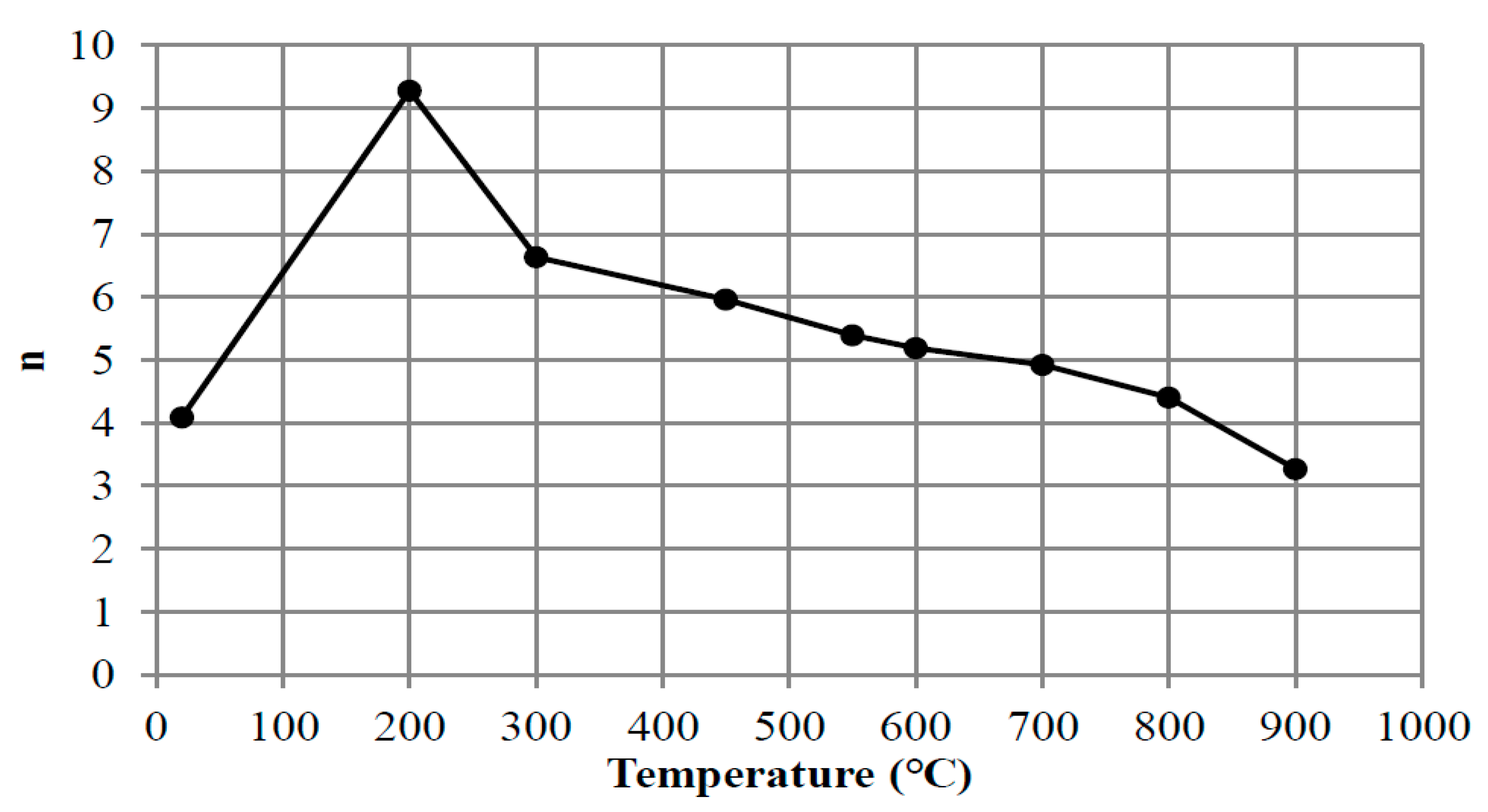

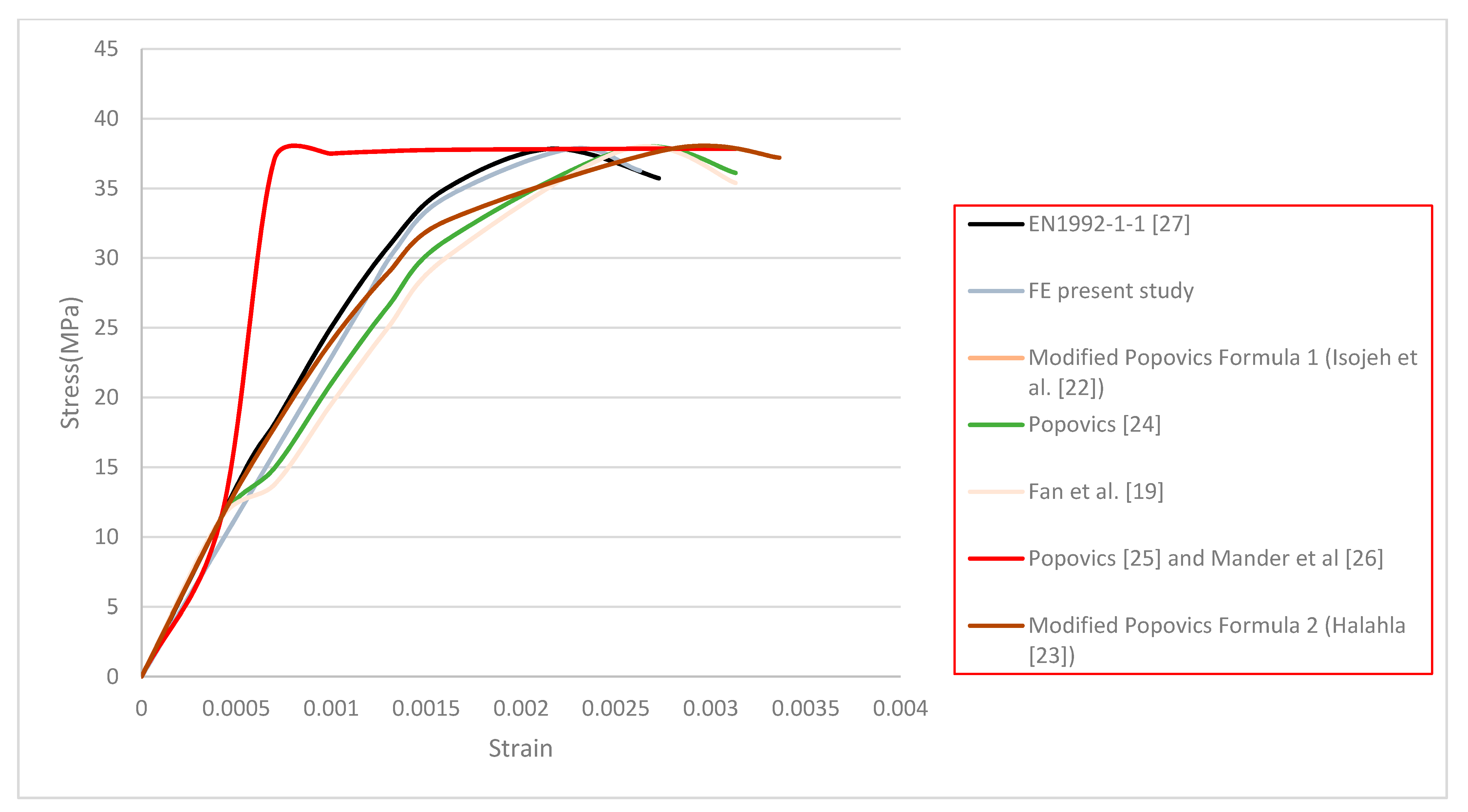
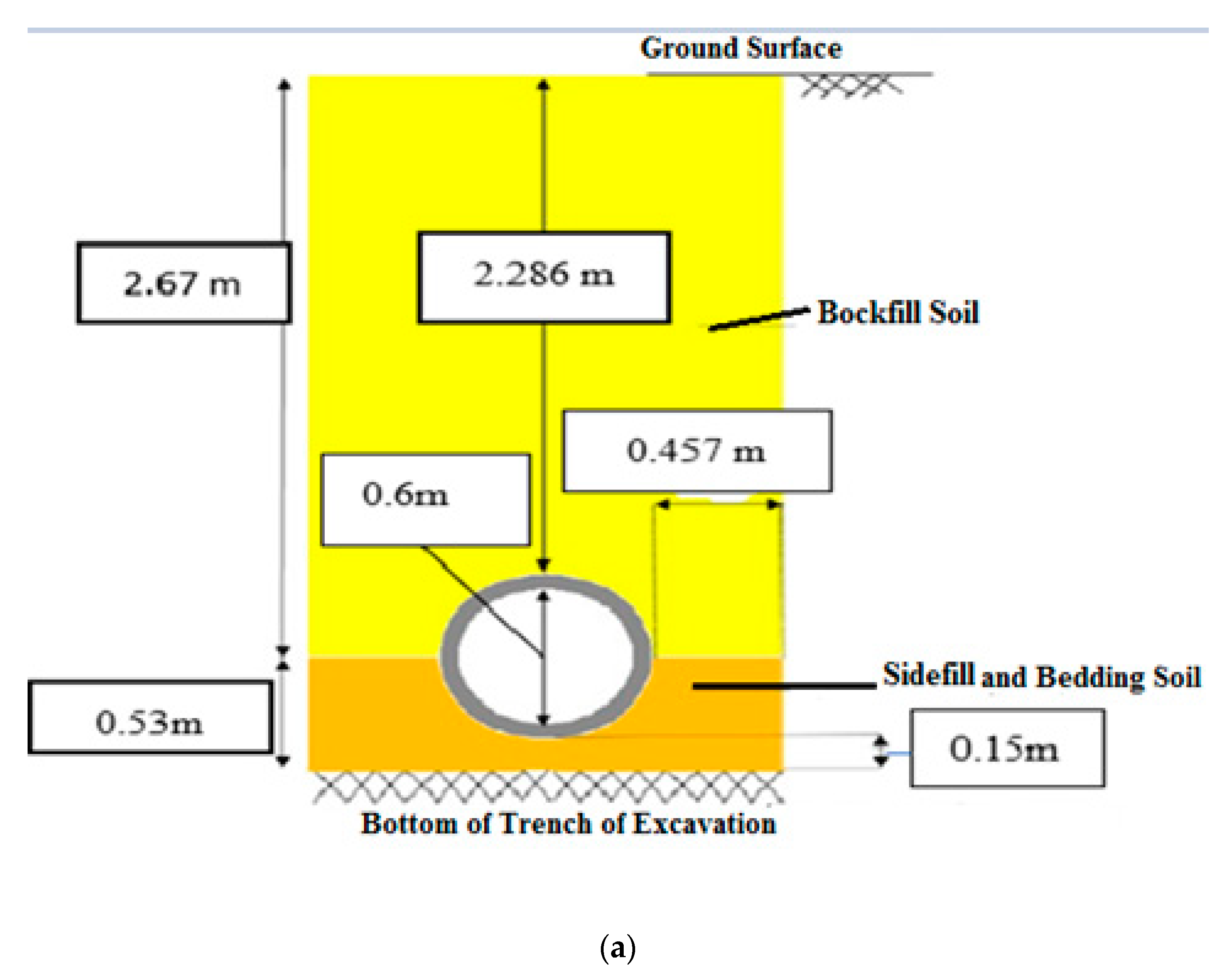
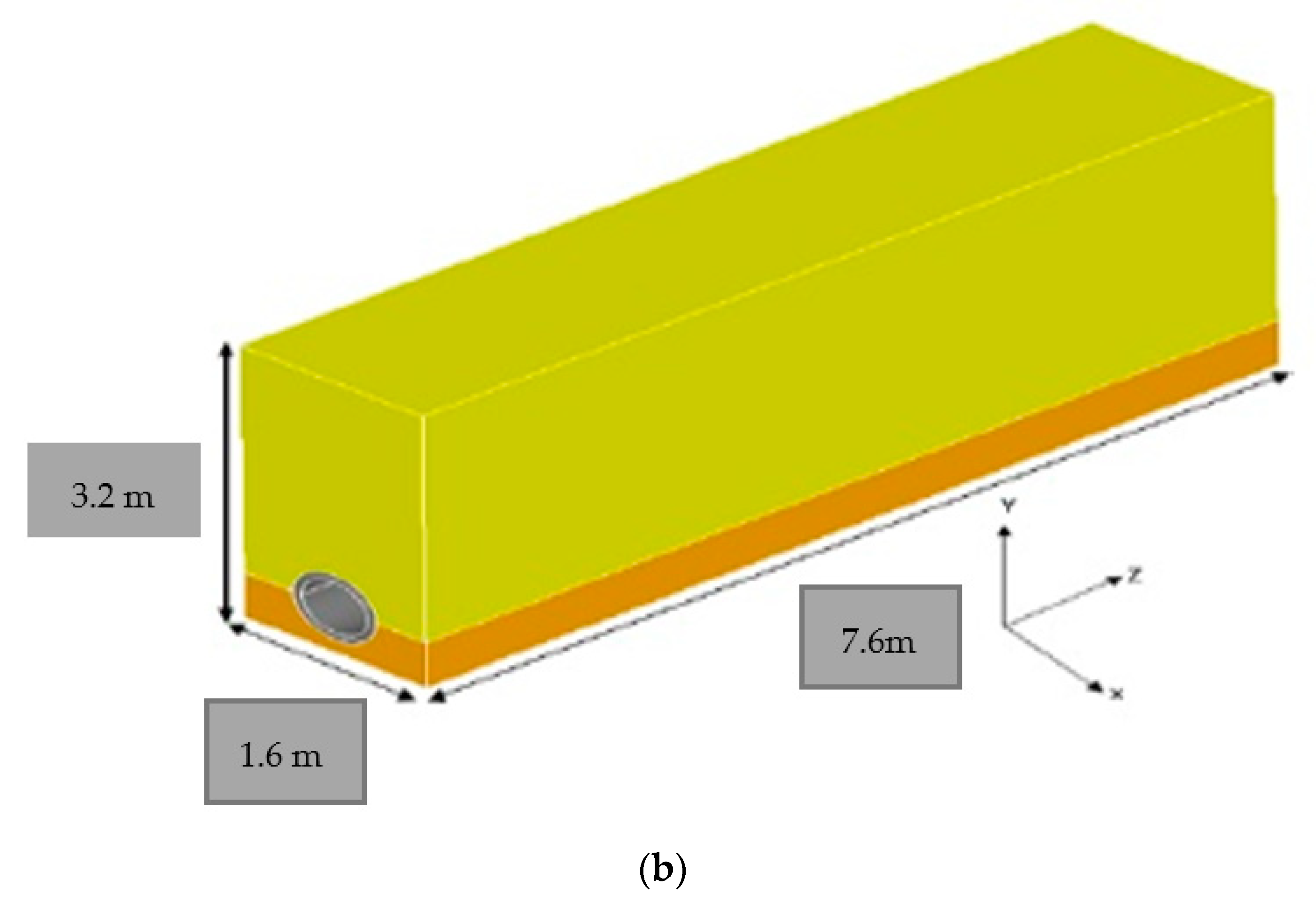
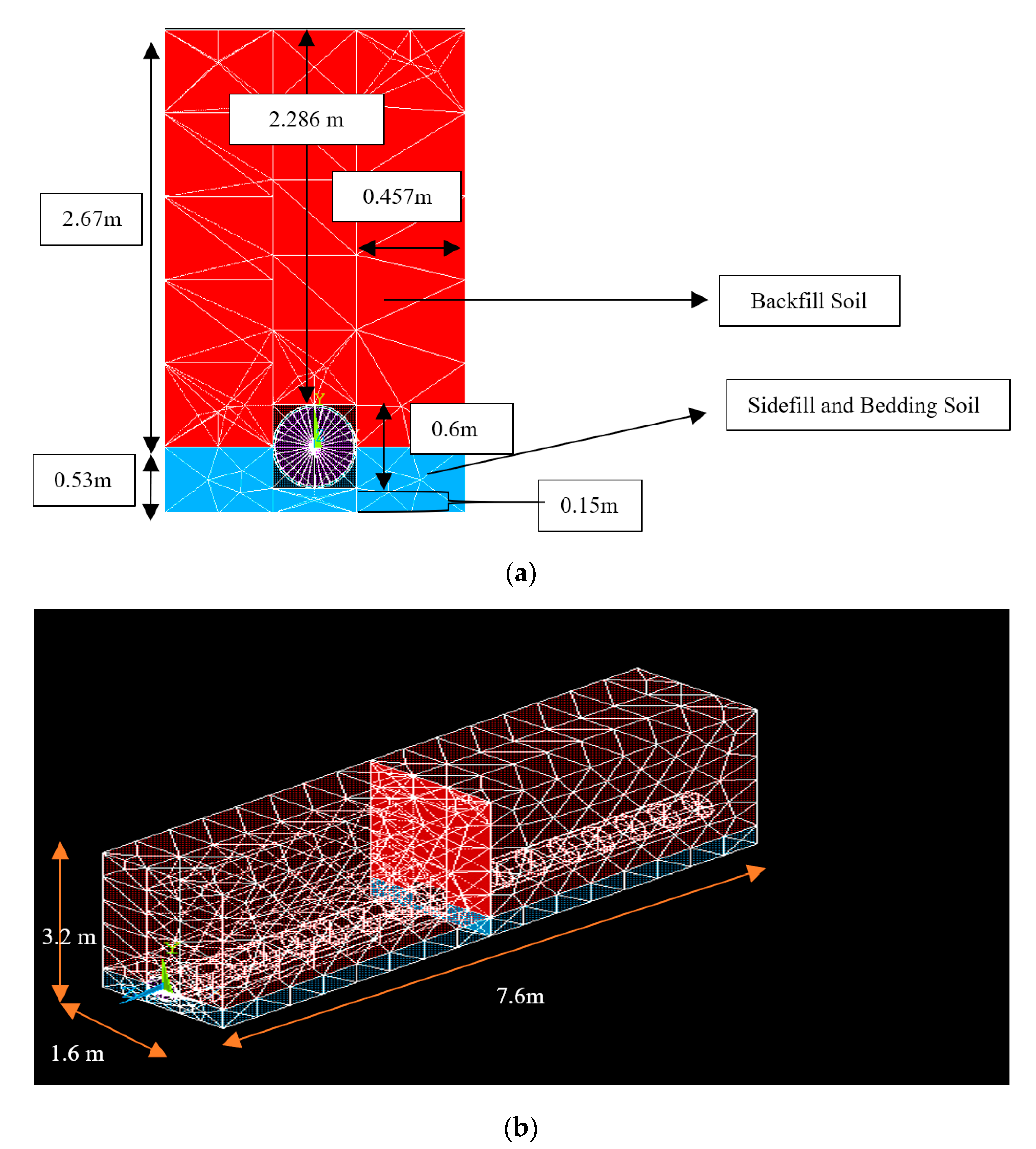
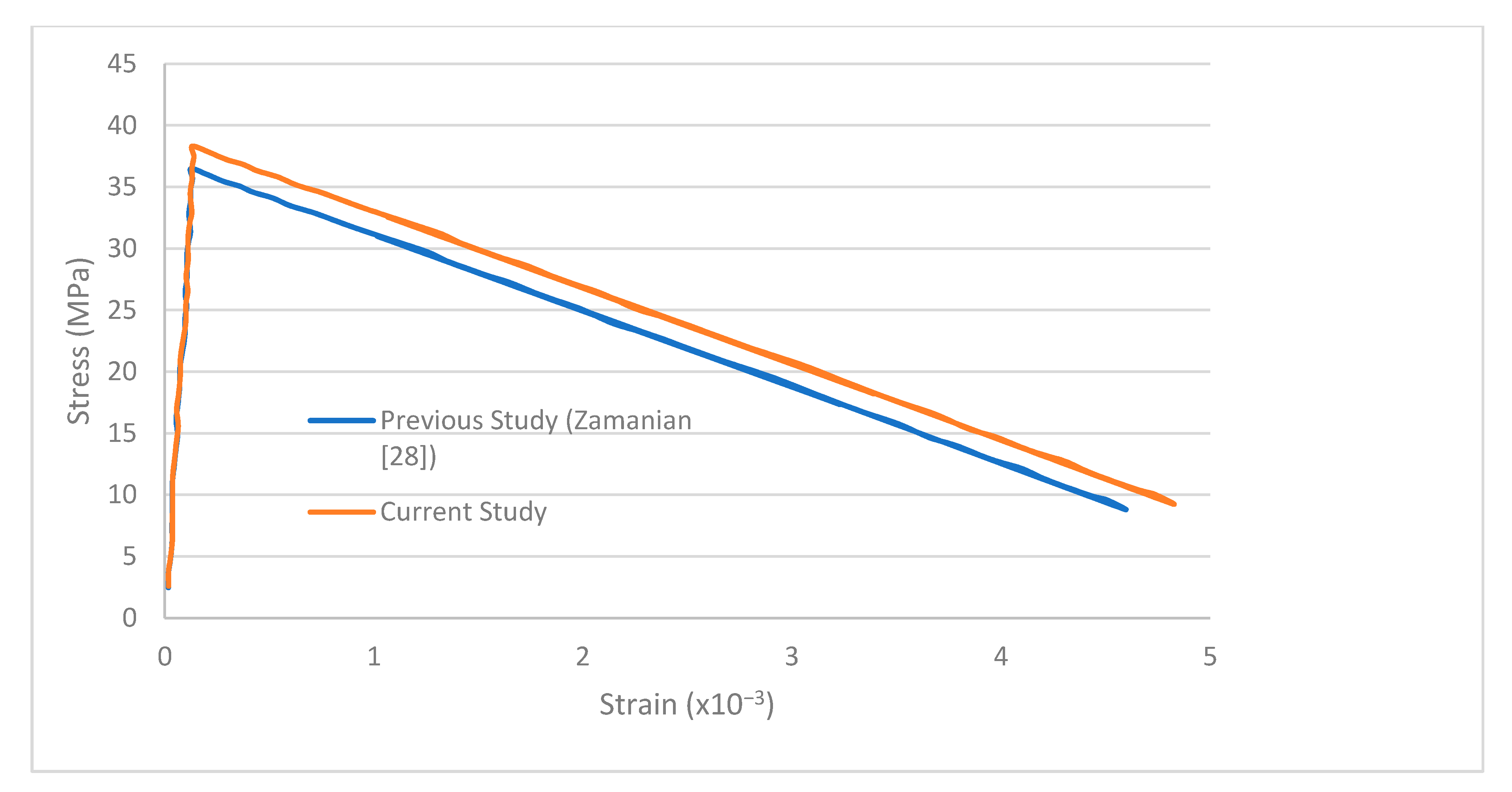
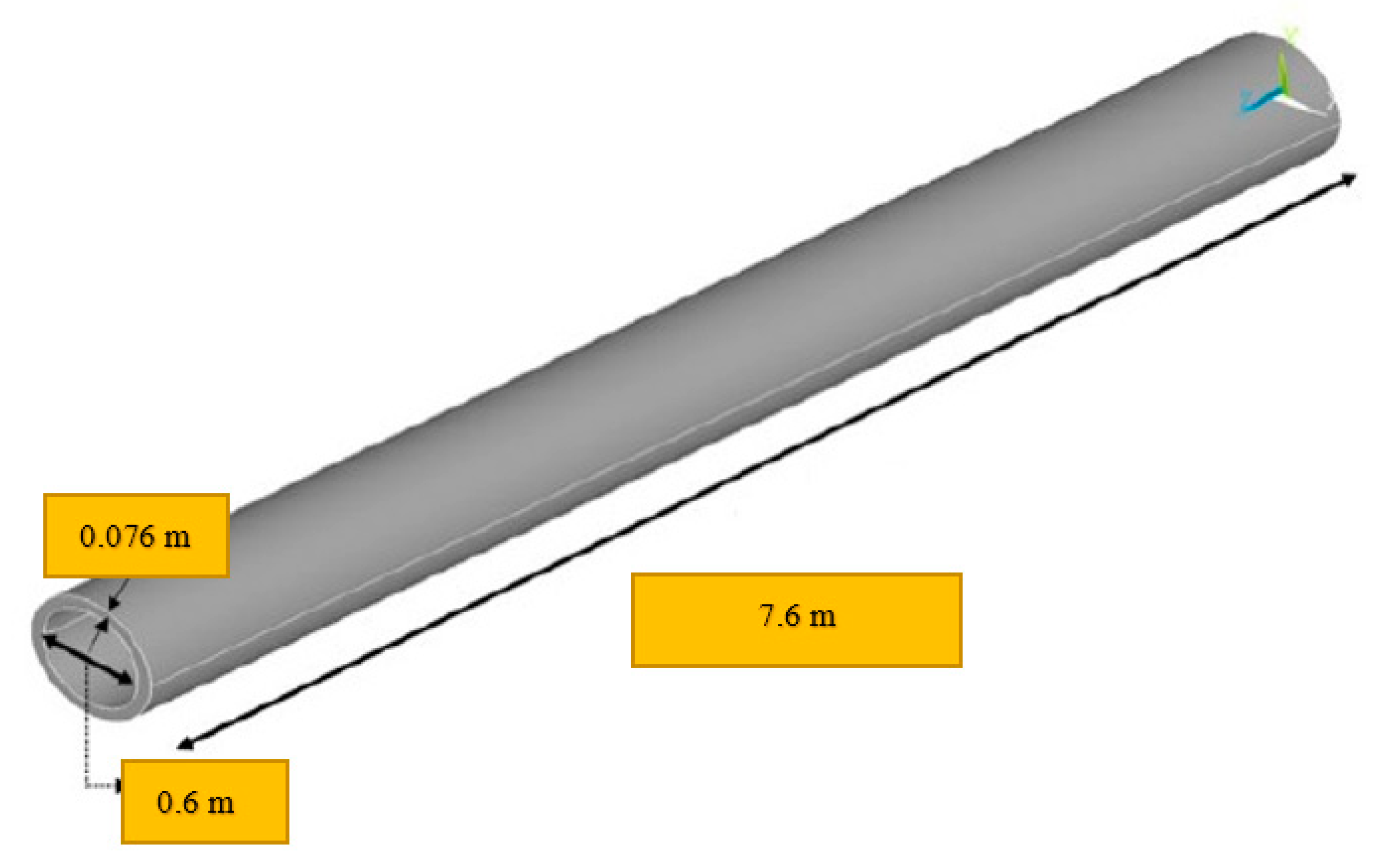
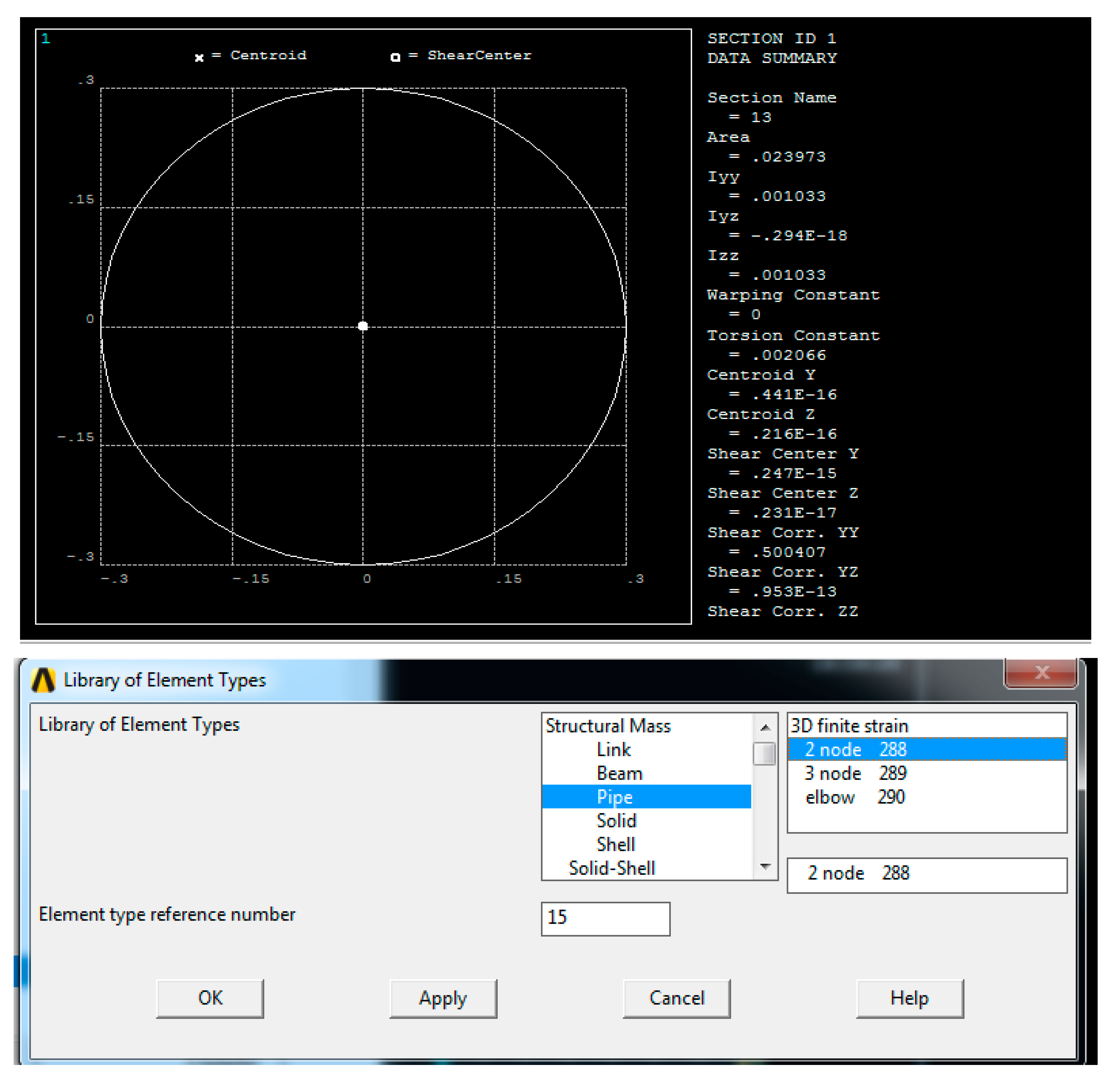
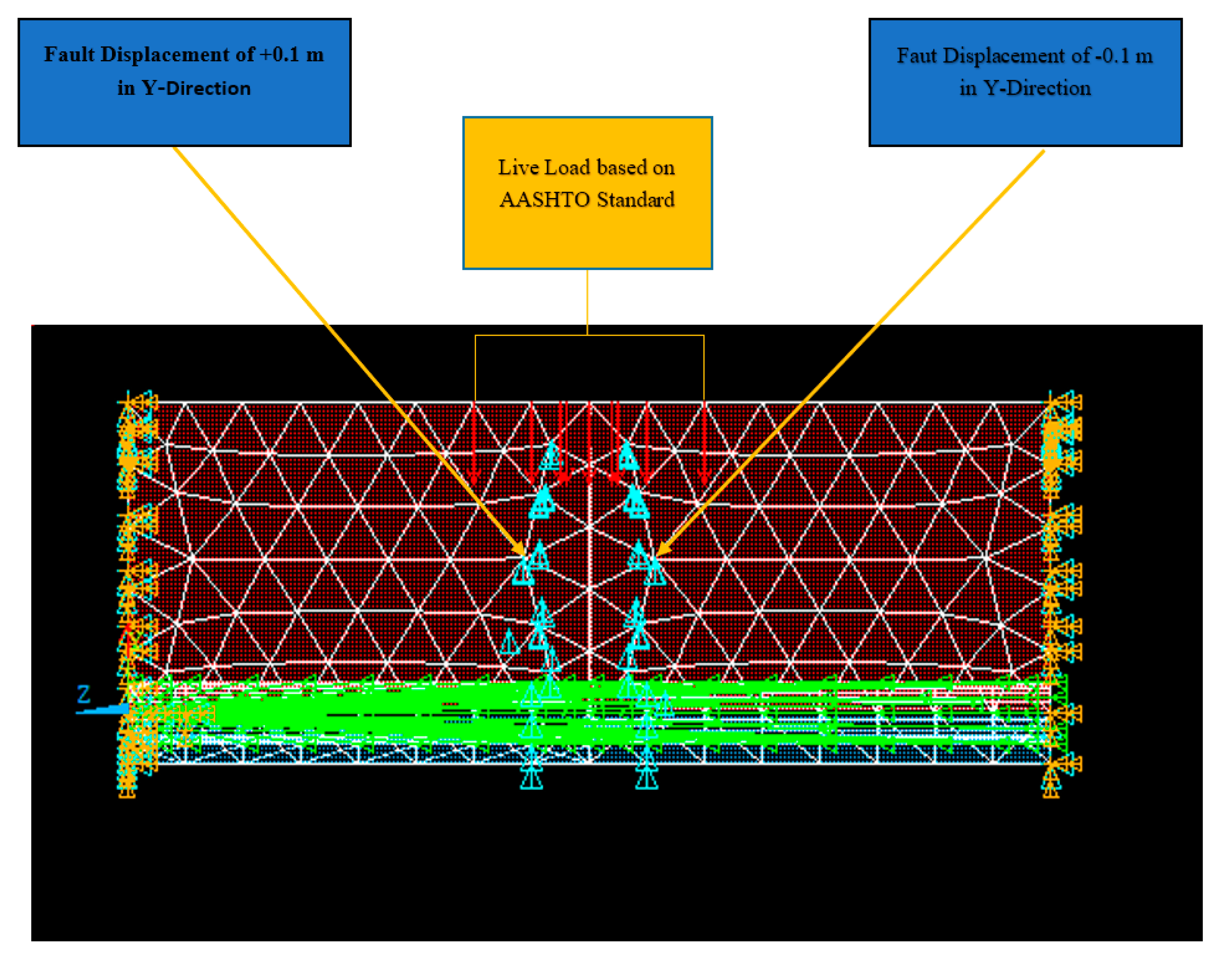
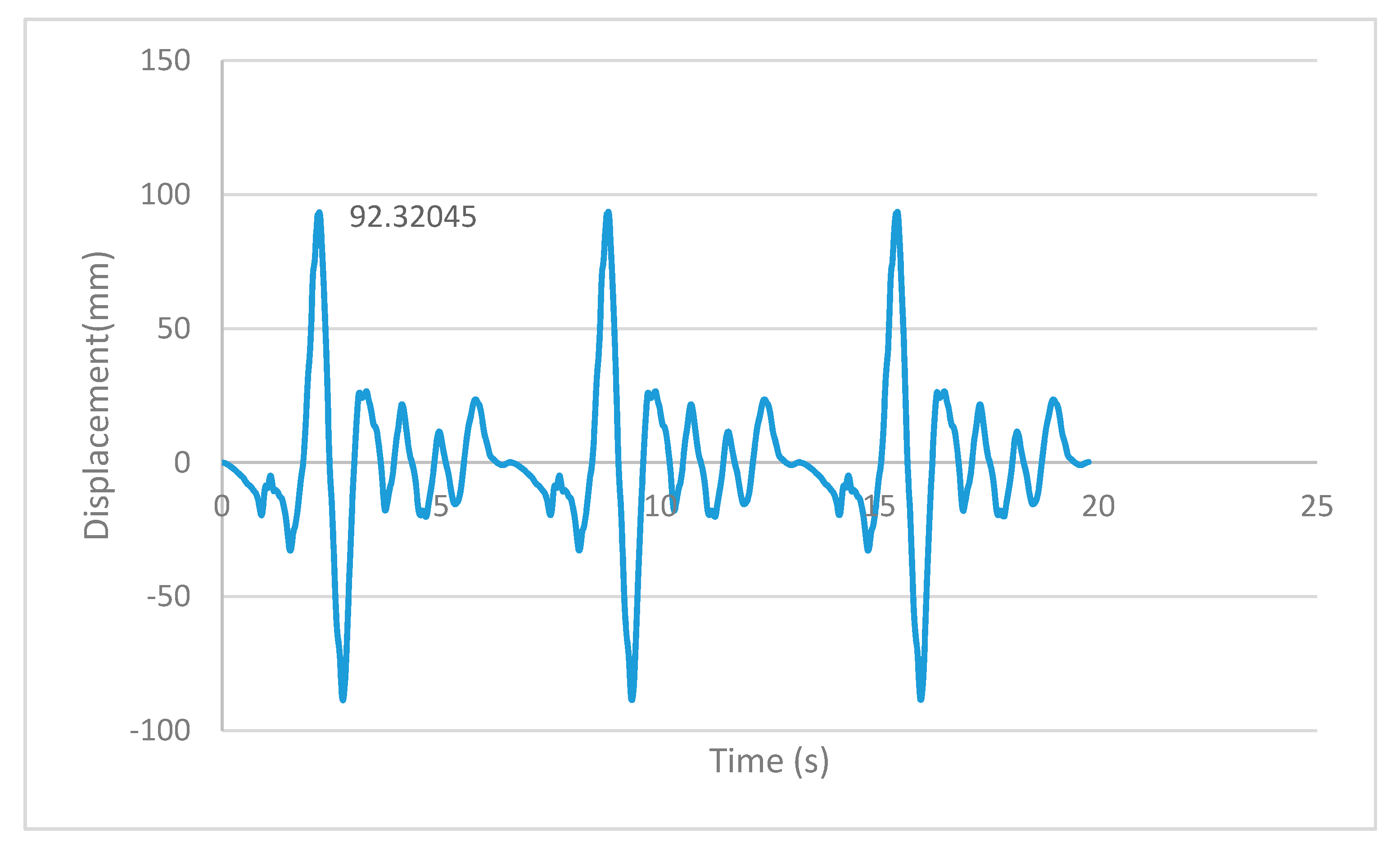

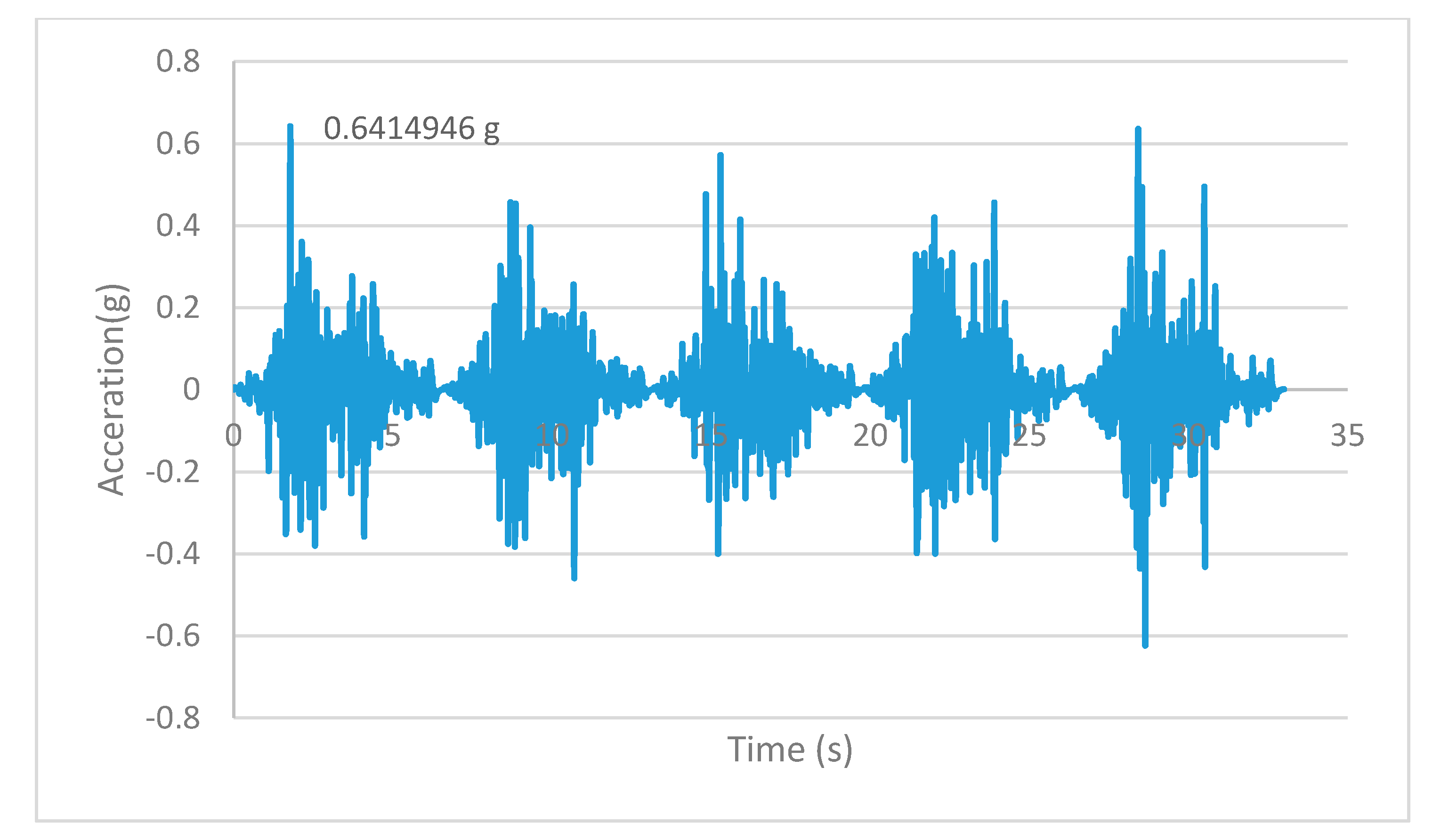
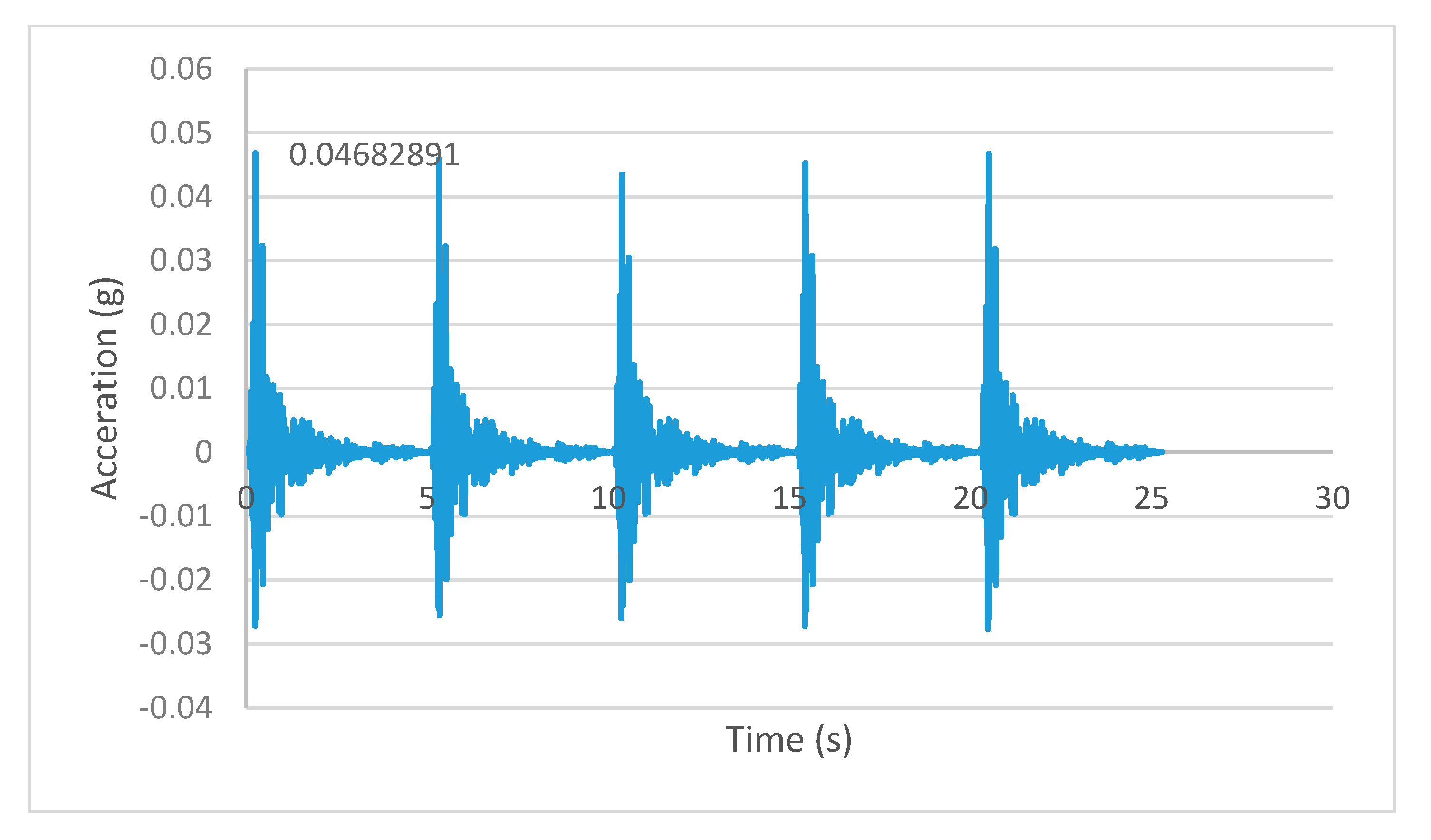

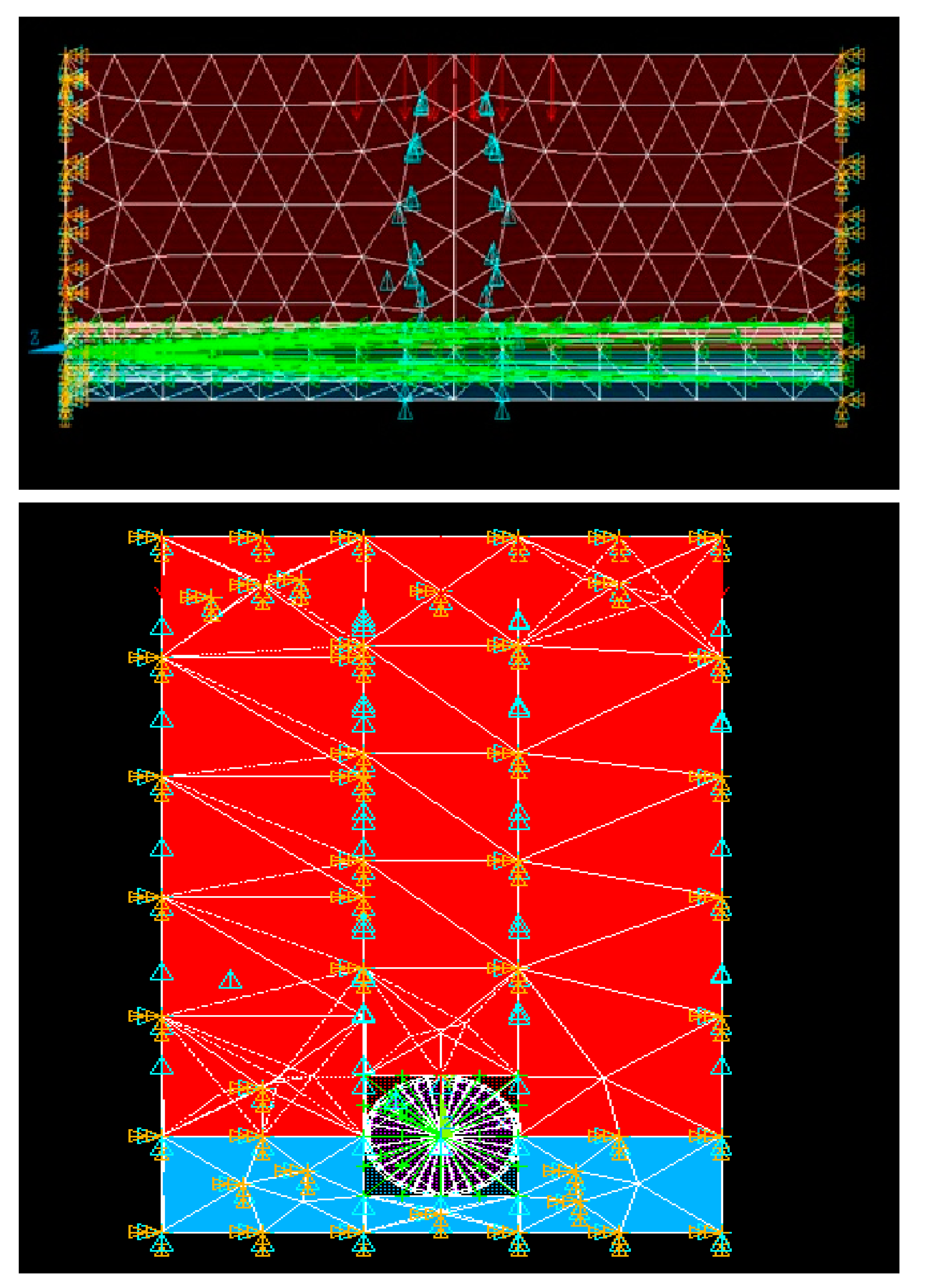
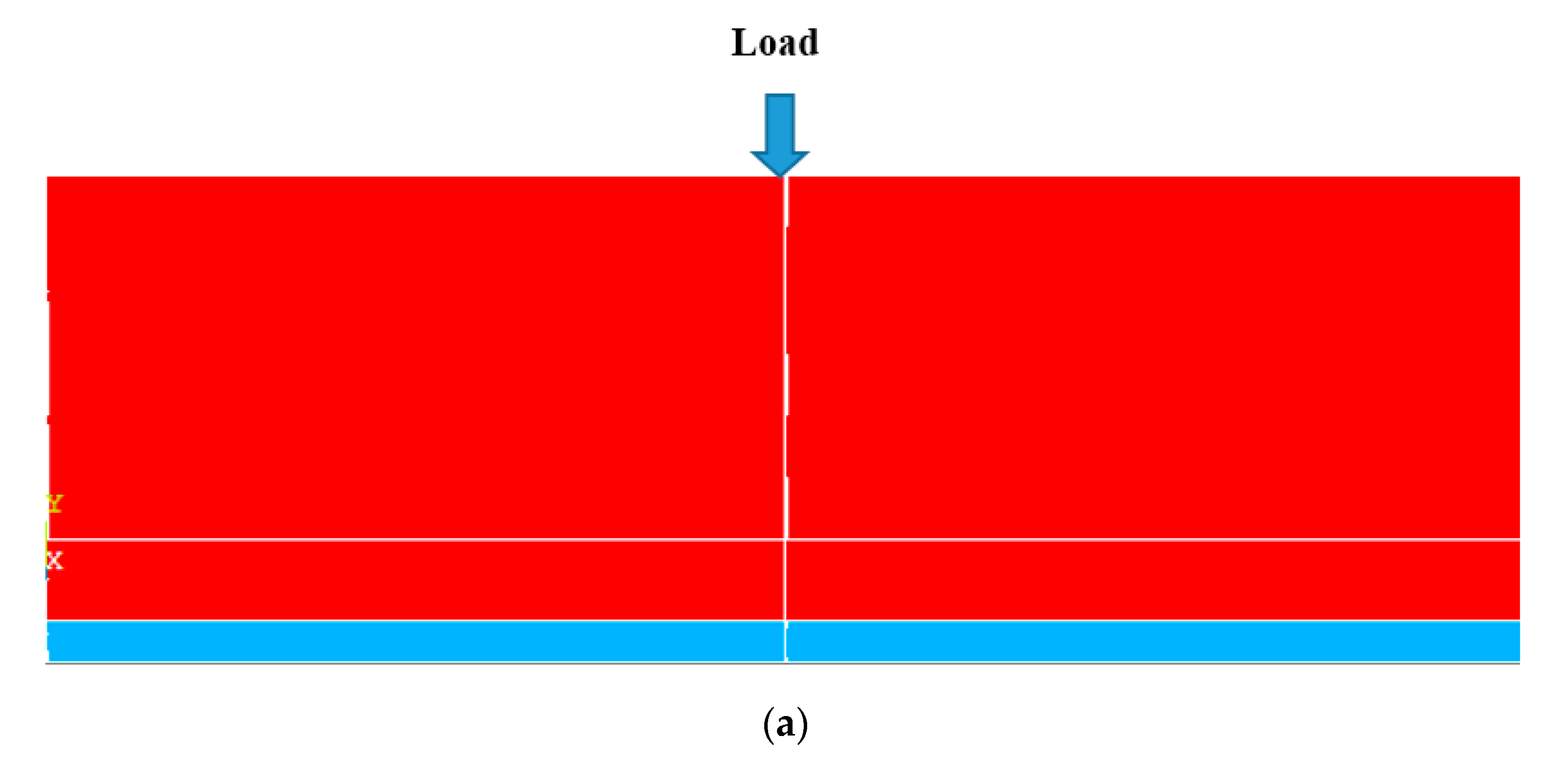
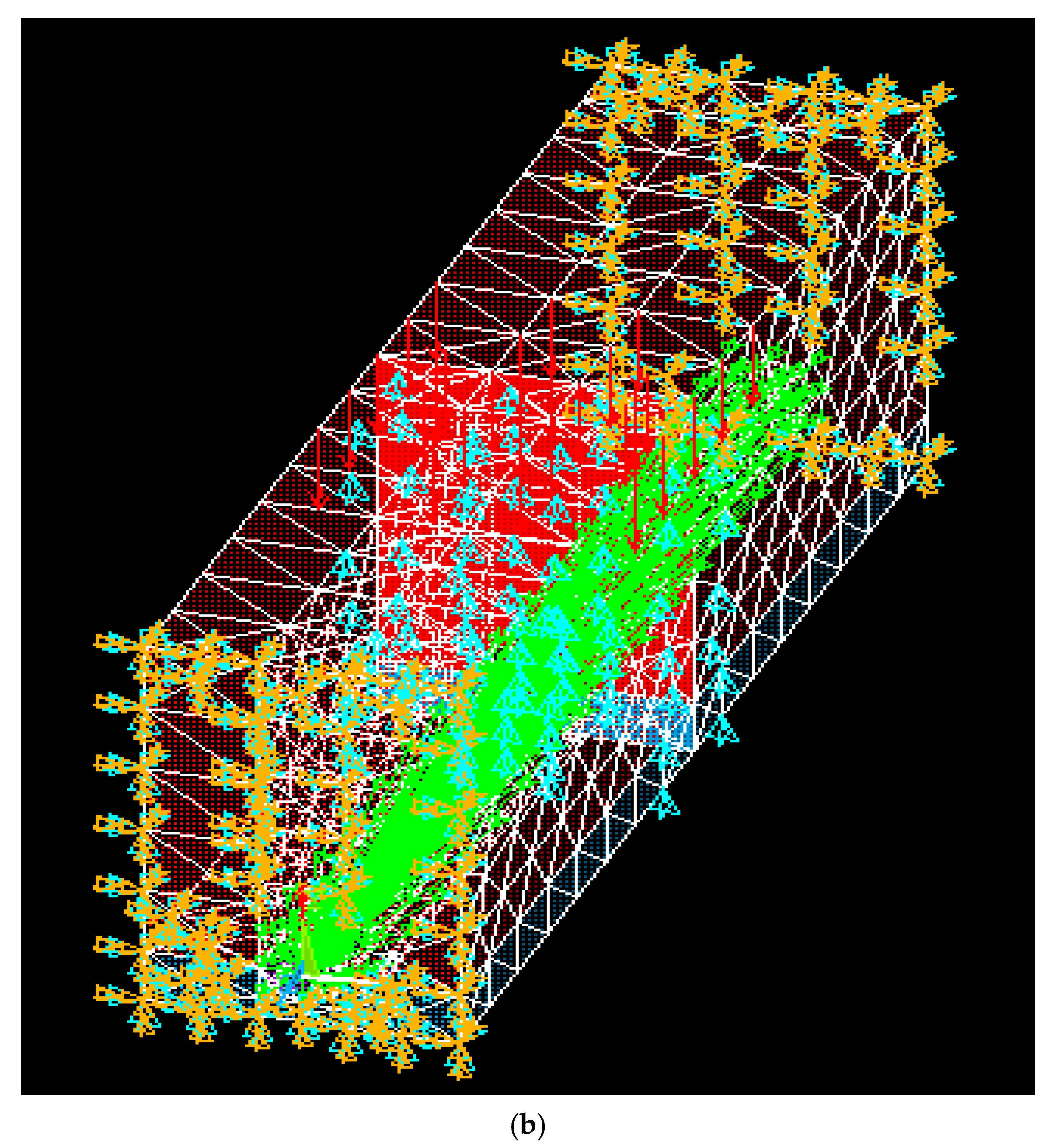
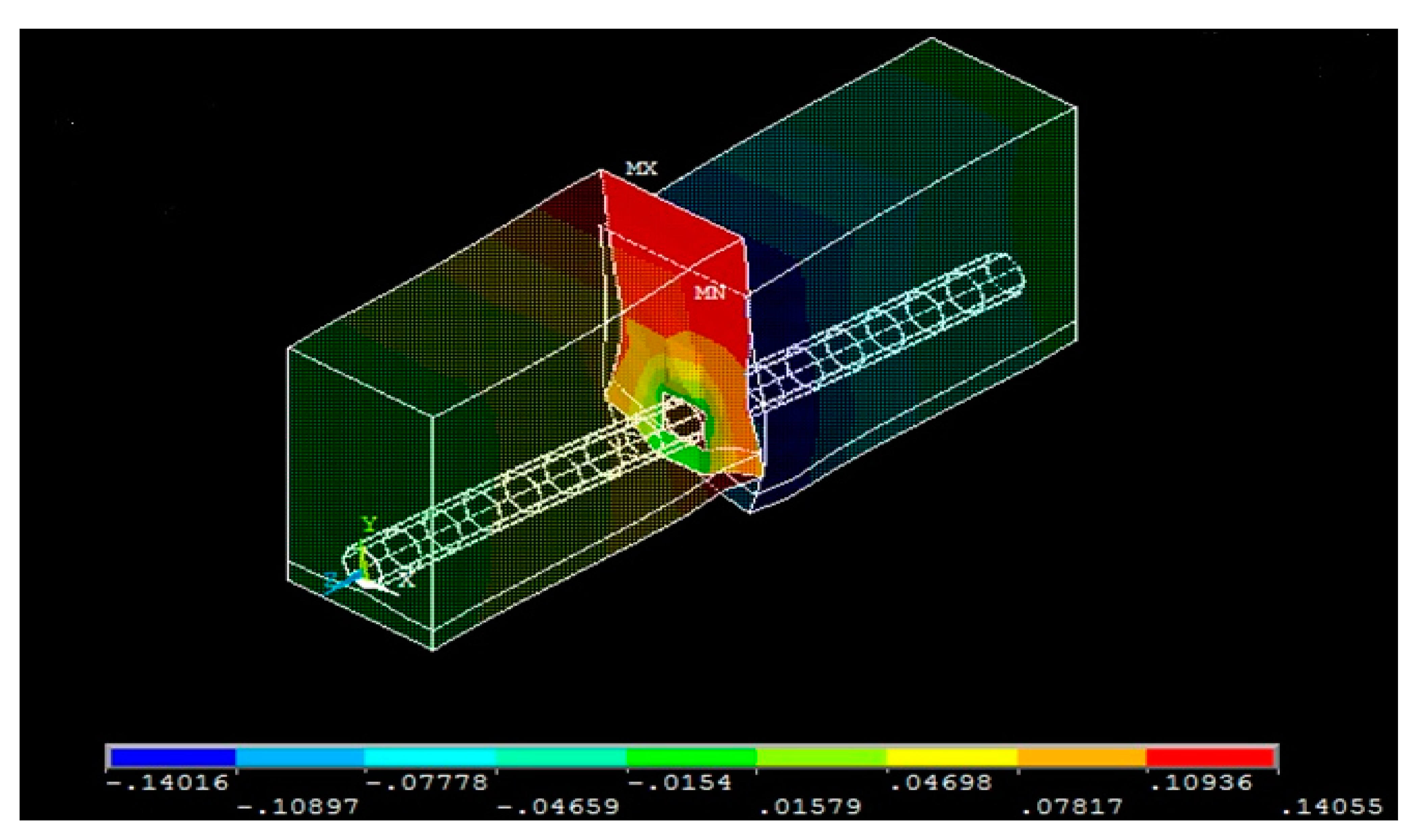
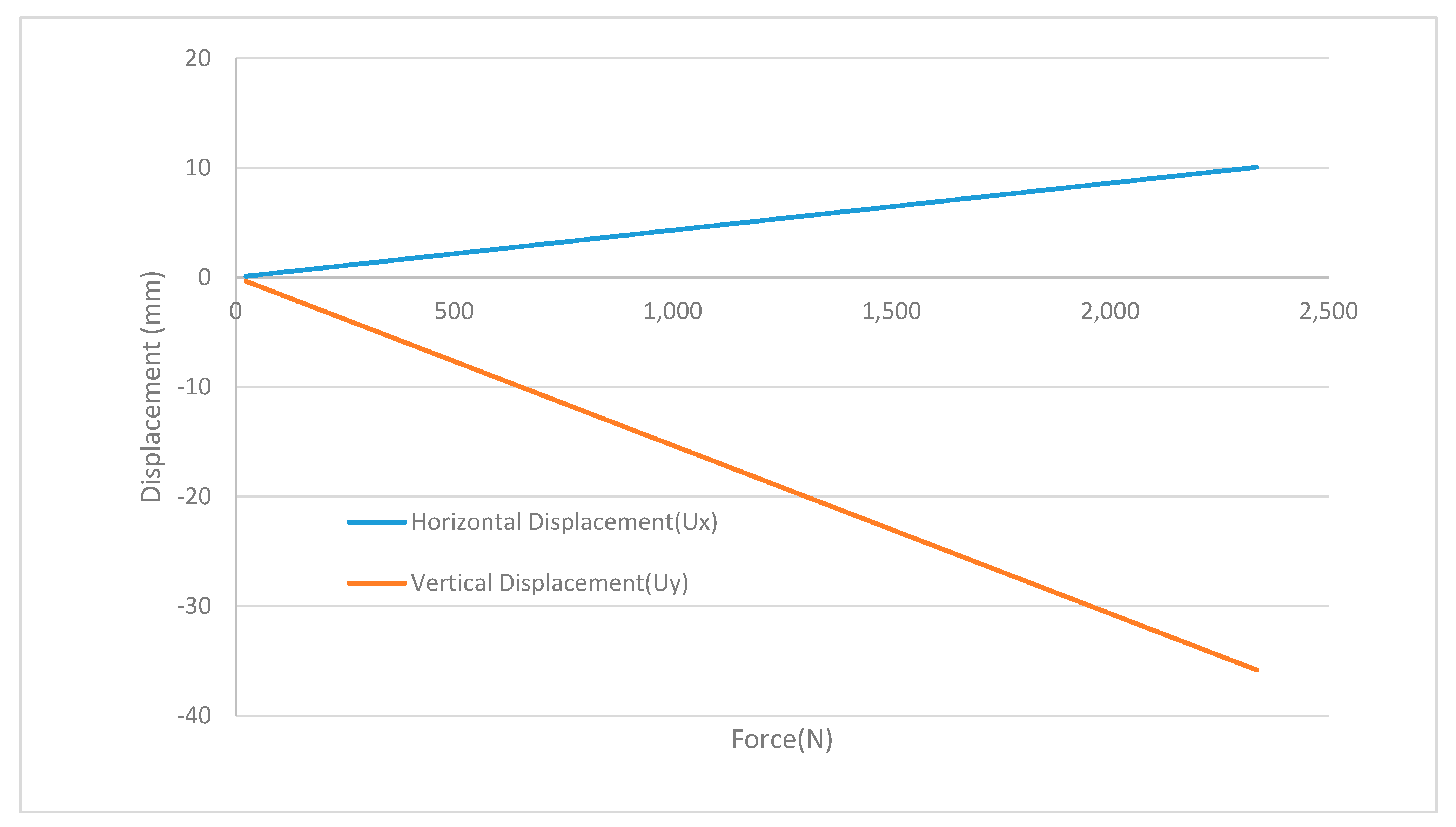
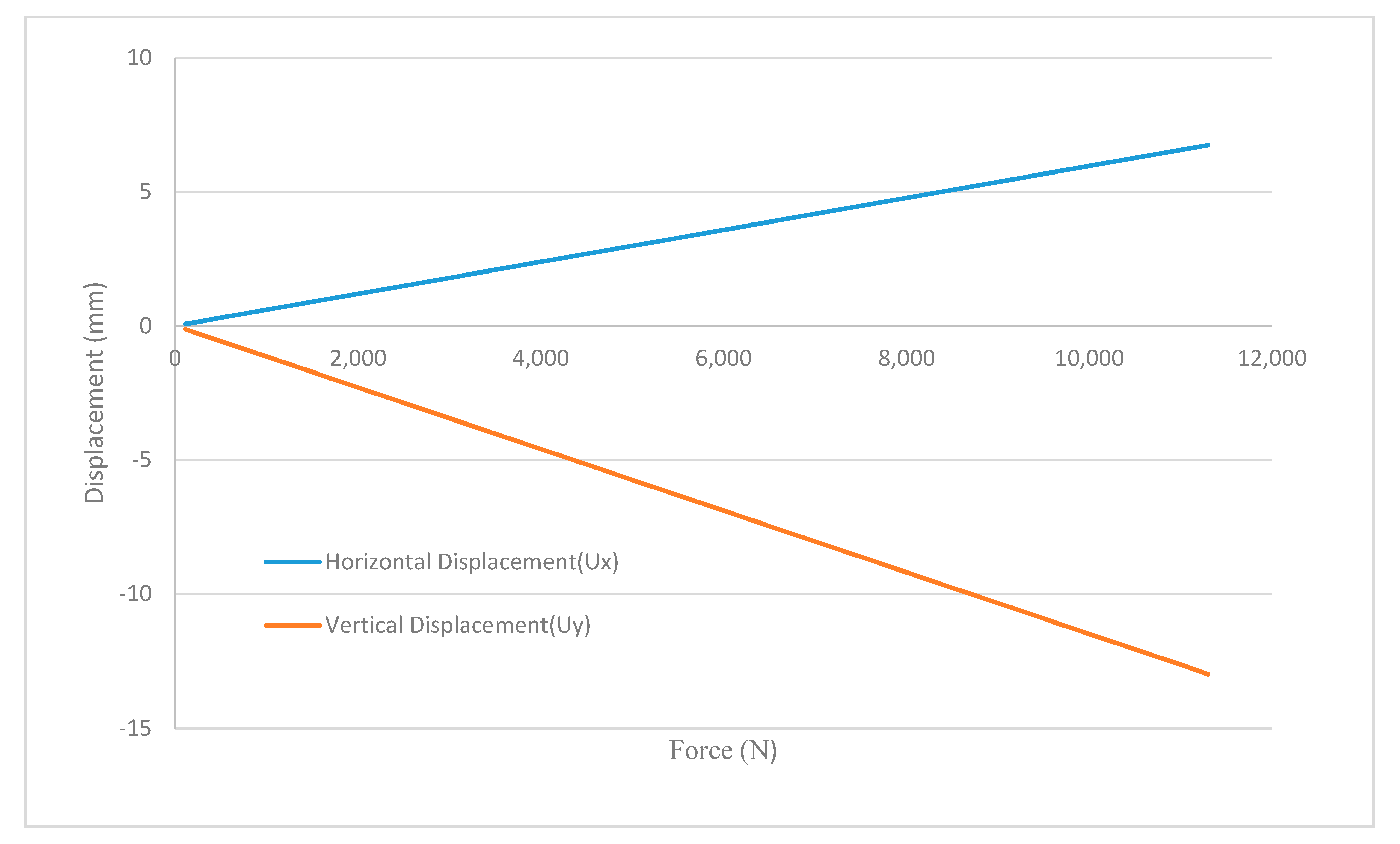


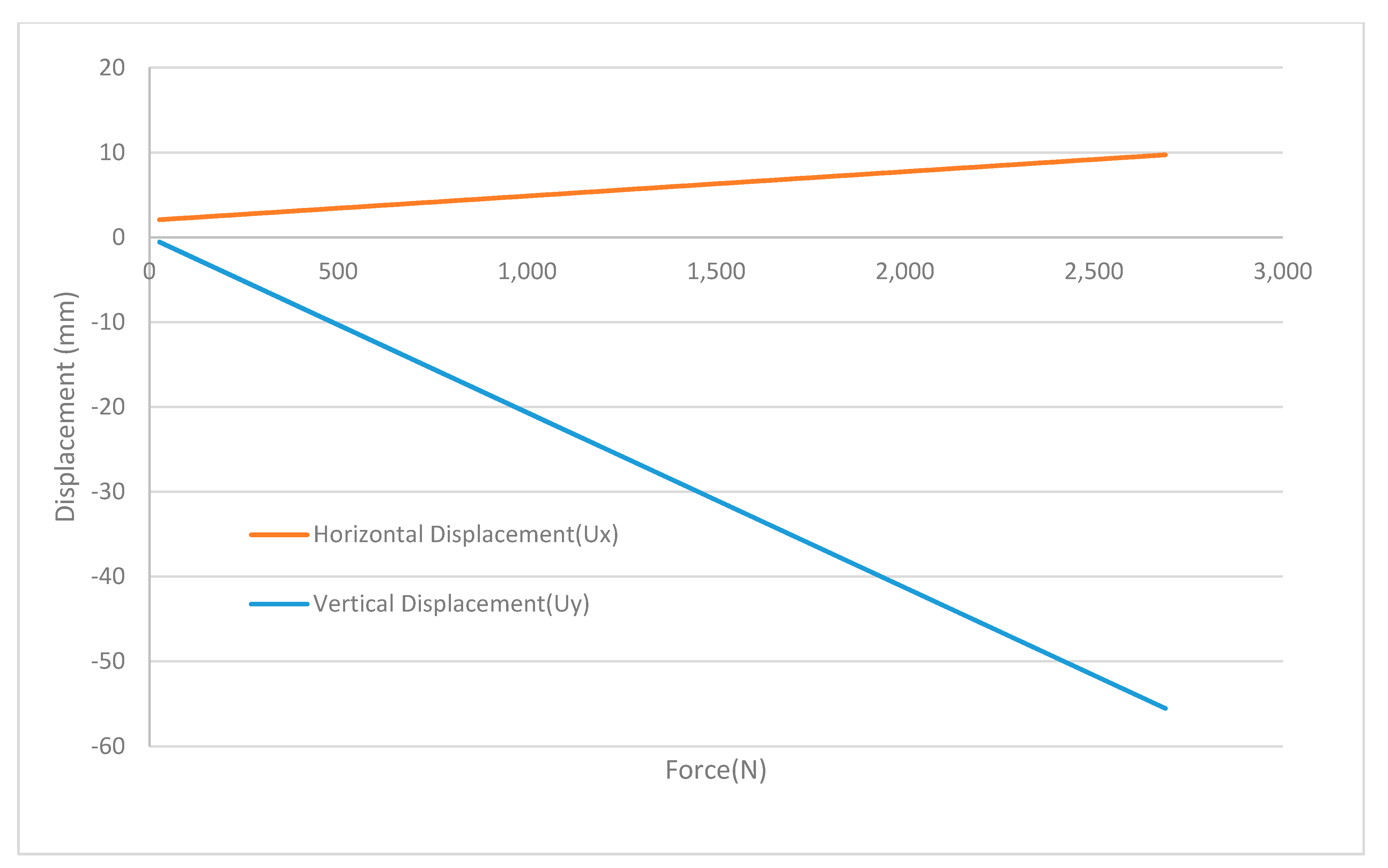
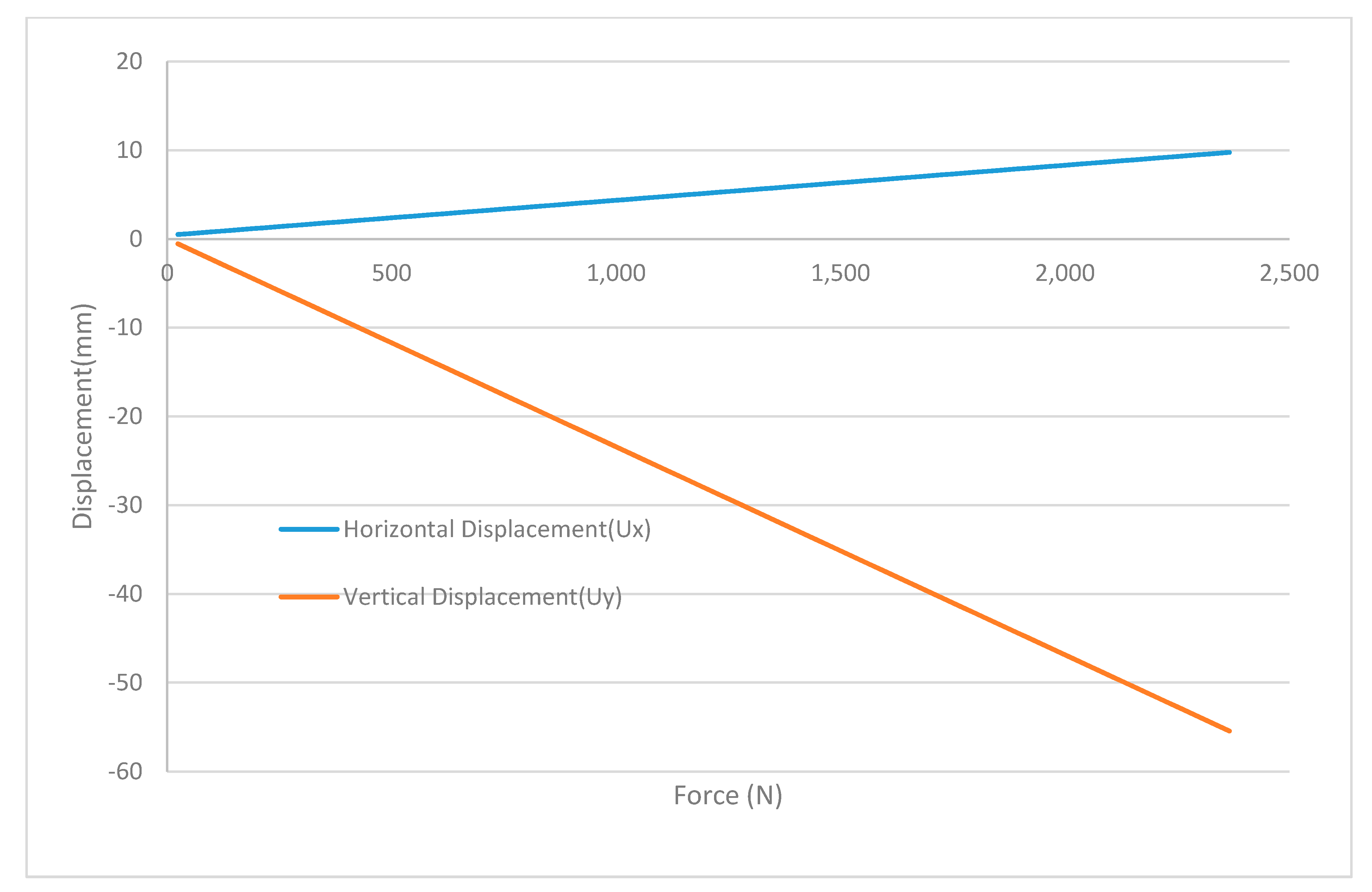
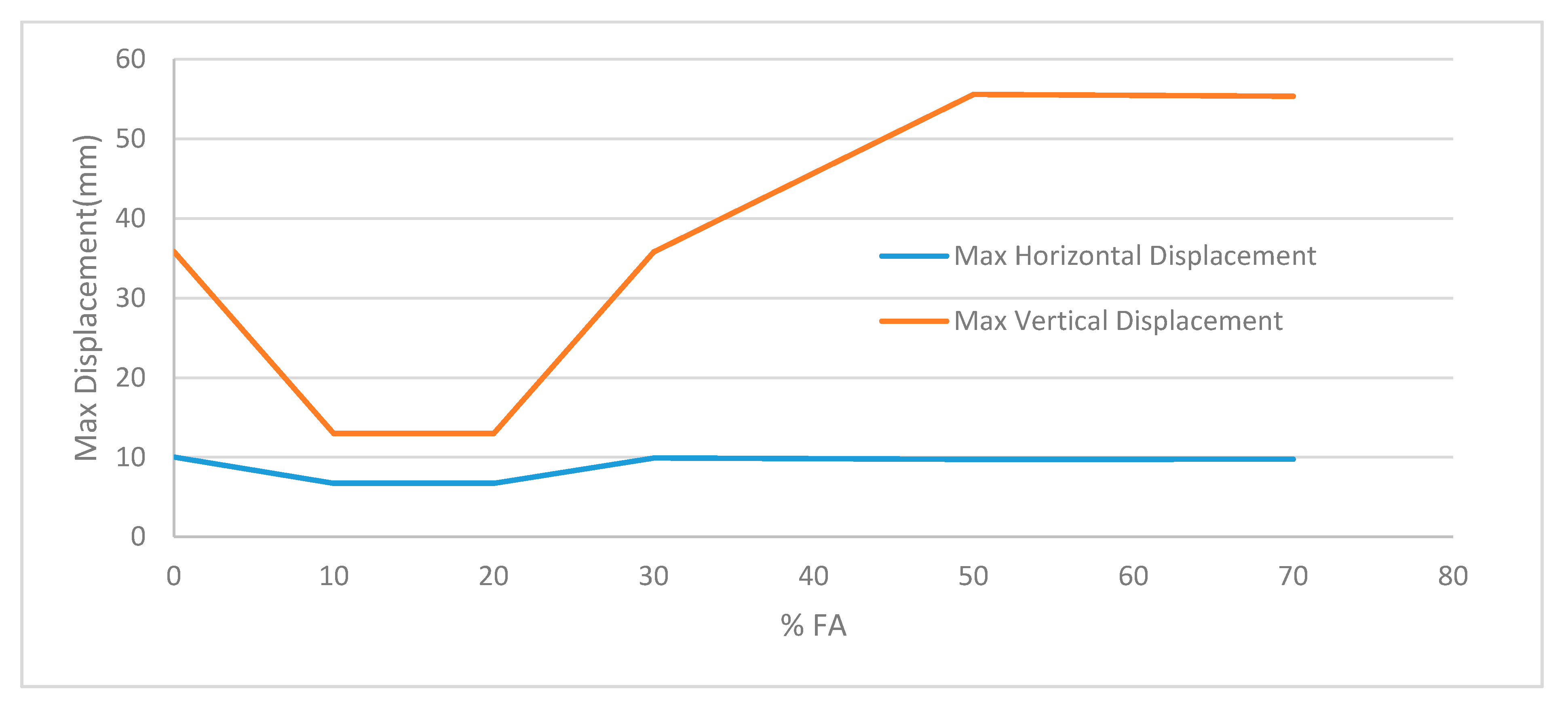
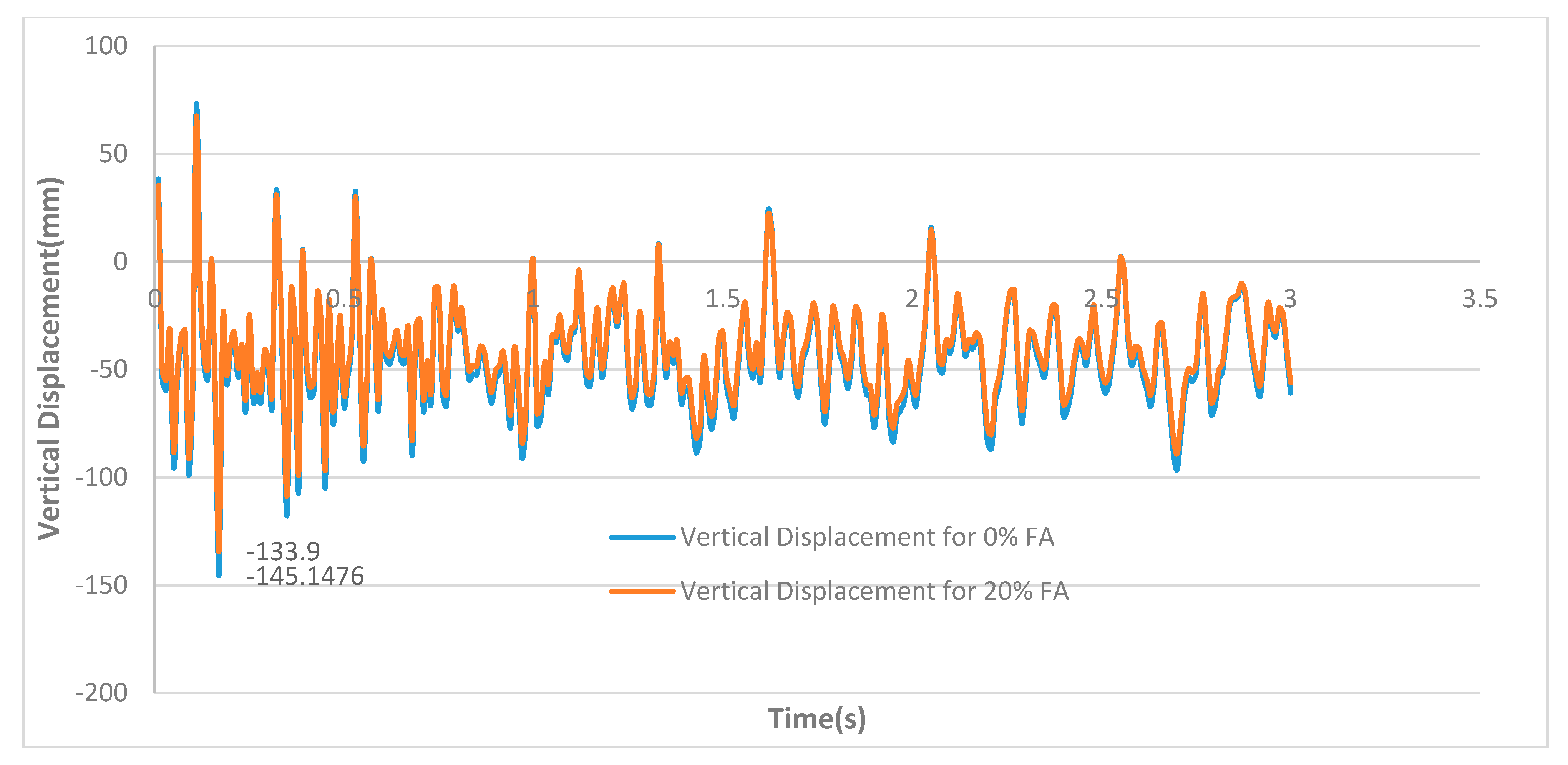
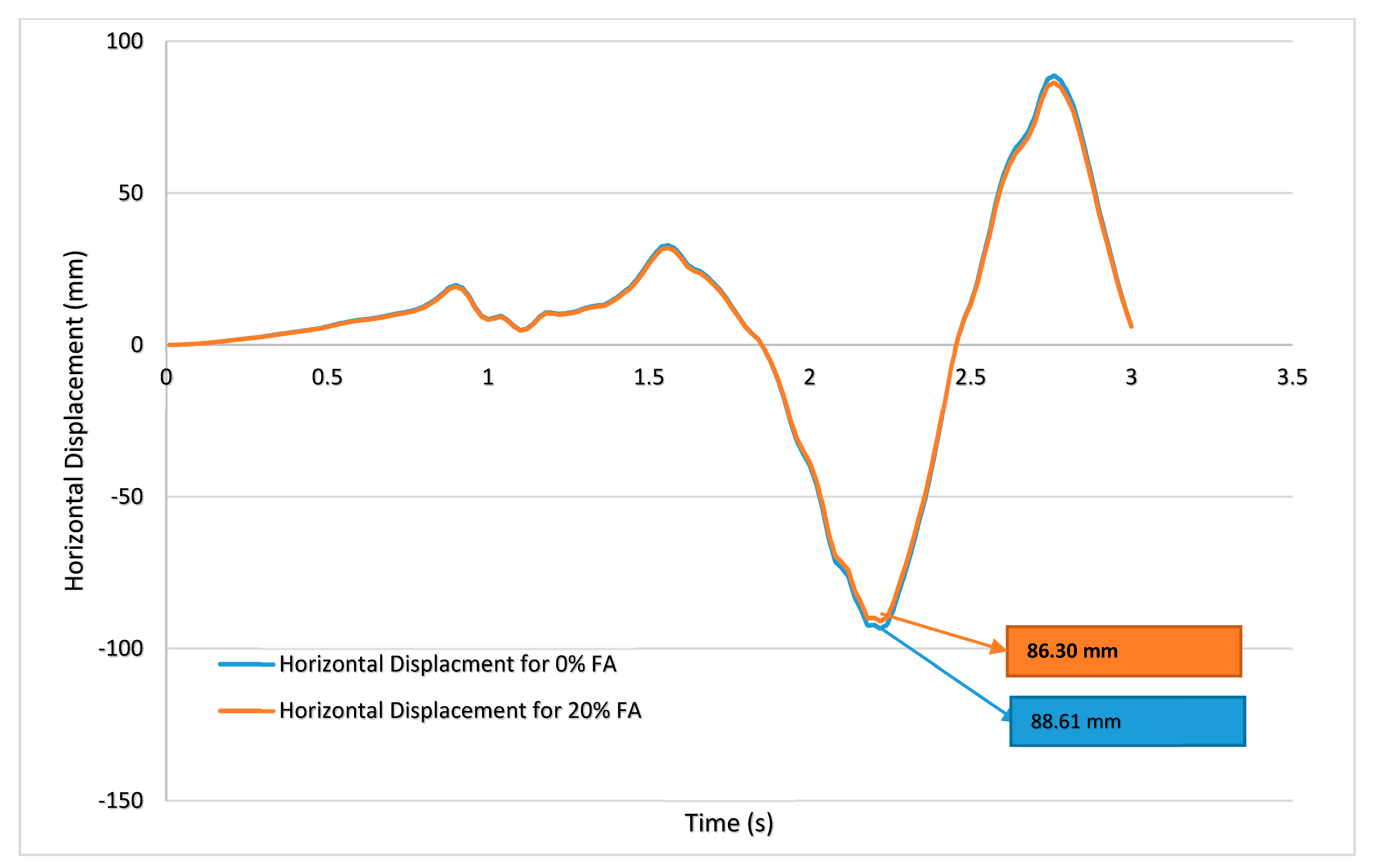

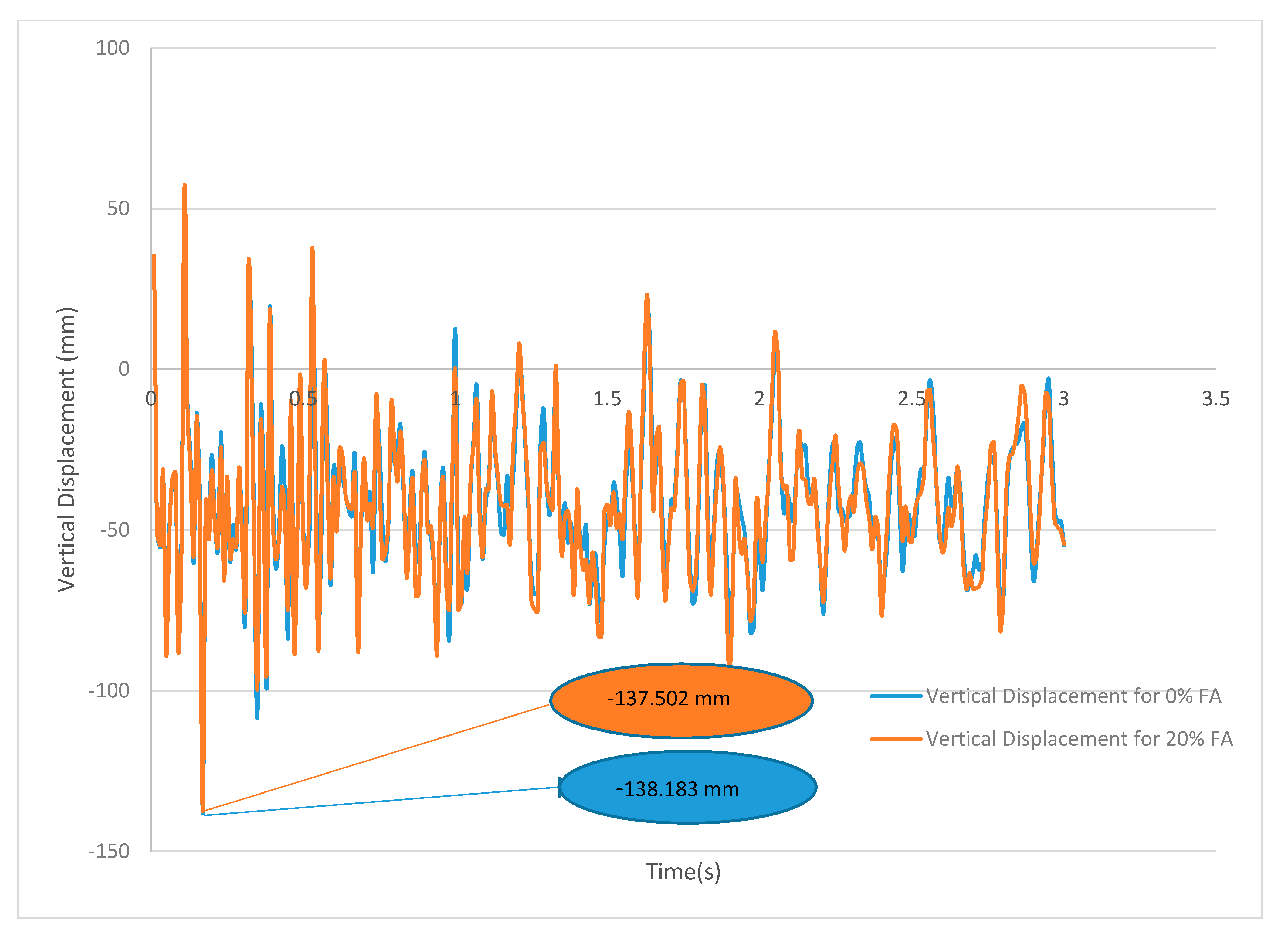
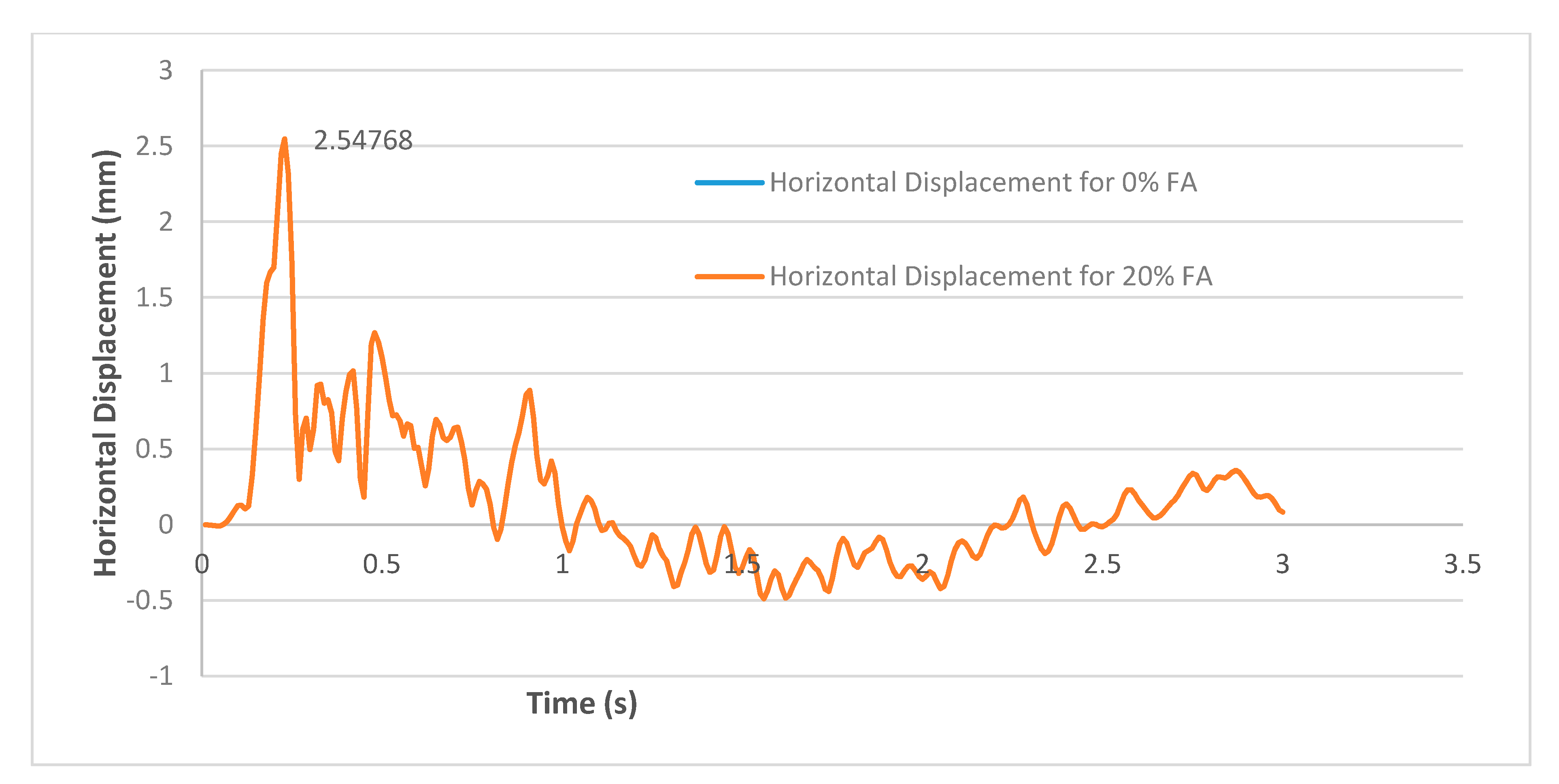
| ANSYS Parameters | Values |
|---|---|
| The shear transfer coefficient for open cracks (βt) | 0.3 |
| The shear transfer coefficient for closed cracks (βC) | 1 |
| Uniaxial cracking stress (fr) | 46.23 MPa |
| Uniaxial crushing stress (f′c) | 38 MPa |
| Biaxial compressive strength (fcb′) | 45.40 MPa |
| Ambient hydrostatic stress (σh) | 65.46 MPa |
| Hydrostatic biaxial crush stress (f1) | 54.86 MPa |
| Hydrostatic uniaxial crash stress (f2) | 65.08 MPa |
| Tensile Crack Factor | 0.6 |
| Elasticity modulus (E) | 22,000 MPa |
| Poisson Ratio | 0.2 |
| Concrete Cube | Ultimate Load (KN) | Compressive Strength (MPa) | Strain at Peak Stress |
|---|---|---|---|
| GPC | |||
| Modified Popovics model (Isojeh et al. [22]) | 851.4 | 37.84 | 0.002086 |
| ANSYS (Present Study) | 858.15 | 38.14 | 0.002262 |
| Static Loads | Gravity (Soil Weight) (N) | 9.81 |
| Traffic Loads (Pa) | 631,000 | |
| Internal sewage water pressure (Pa) | 276,000–414,000 |
| Density | Total Static Loading | Element Type | ||||||||||
|---|---|---|---|---|---|---|---|---|---|---|---|---|
| Material Type | lb/In3 | Kg/m3 | Lbs | N | Concrete | Soil | Poisson Ratio (ν) | βt | βc | |||
| Concrete | 0.0868 | 2402 | 450,006 | 200,198 | Previous Study | Current Study | Previous Study | Current Study | Concrete | 0.2 | 0.3 | 1 |
| Sidefill & Bedding Soil | 0.0625 | 1730 | Solid 65 | Pipe 288 | Solid 65 | Solid 185 | Sidefill & Bedding Soil | 0.25 | N/A | N/A | ||
| Backfill Soil | 0.0734 | 2032 | Backfill Soil | 0.3 | N/A | N/A | ||||||
| Parameters Material Type | Elastic Properties | Plastic Properties | Element Type | Internal Friction Coefficient Soil-Pipe | |||
|---|---|---|---|---|---|---|---|
| GPC Concrete | Elasticity Modulus (GPa) | 15–22 | βt | 0.2 | Pipe 288 | 0.6–0.7 | |
| βc | 0.8 | ||||||
| Poisson Ratio (ν) | 0.25 | Tensile Crack Factor | 0.6 | ||||
| Density (Kg/m3) | 2420 | ||||||
| Soil | Sidefill & Bedding (Cohesive) | Elasticity Modulus (GPa) | 0.019 | Cohesive Strength (C-Kpa) | 17–252 | Solid 185 | |
| Poisson Ratio (ν) | 0.25 | Friction Angle (φ) | 20–29 | ||||
| Density (Kg/m3) | 1730 | Dilation angle (Ψ) | 2 | ||||
| Backfill (Sandy) | Elasticity Modulus (GPa) | 0.028 | Cohesive Strength (C-Kpa) | 0–17 | |||
| Poisson Ratio (ν) | 0.3 | Friction Angle (φ) | 35–40 | ||||
| Density (Kg/m3) | 2032 | Dilation angle (Ψ) | 2 | ||||
| Pipe Geometry | In | M |
|---|---|---|
| Internal Diameter | 24 | 0.6 |
| Wall Thickness | 3 | 0.076 |
| Pipe Length | 300 | 7.6 |
| Installation Type | Bedding Thickness | Haunch and Outer Bedding | Lower Side |
|---|---|---|---|
| Type 1 | minimum, not less than 150 mm | 95% Category I | 90% Category I, 95% Category II, Or 100% Category III |
| Type 2 | minimum, not less than 150 mm | 90% Category I Or 95% Category II | 85% Category I, 90% Category II, Or 95% Category III |
| Type 3 | minimum, not less than 150 mm | 85% Category I, 90% Category II, Or 95% Category III | 85% Category I, 90% Category II, Or 95% Category III |
| Type 4 | minimum, not less than 150 mm | No Compaction is required, except if Category III, Use 85% | No Compaction is required, except if Category III, Use 85% |
| Static Loads | Gravity (Soil weight) N | 9.81 |
| Traffic loads (Pa) | 74,137 | |
| Internal sewage water pressure in the pipe | 276,000–414,000 Pa | |
| Fault displacement in the middle part of GPC pipe | 0.1 m | |
| Seismic Loads (1) (Tabas (Iran), 1978) | Peak displacement of TABAS earthquake (m) | 0.093 m |
| History time (s) | 19.78 (s) | |
| Seismic Loads (2) (Friuli (Italy), 1981) | Peak displacement of Friuli earthquake (m) | 0.025 m |
| History time (s) | 15.175 (s) |
| Material Type | No. | Density (Kg/m3) |
|---|---|---|
| GPC concrete | 1 | 2420 |
| Internal fluid (Sewage) | 2 | 706 |
| Backfill (Soil type 1) | 3 | 2032 |
| Sidefill and Bedding (Soil type 2) | 4 | 1730 |
| Mix | % FA | Compressive Strength (MPa) | Curing Conditions | |
|---|---|---|---|---|
| 7 Days | 28 Days | Water Bath at 21 °C | ||
| PF10000 | 0 | 21.56 | 31.93 | Water Bath at 21 °C |
| PF9010B | 10 | 24.99 | 36.63 | Water Bath at 21 °C |
| PF8020 | 20 | 25.24 | 37.84 | Water Bath at 21 °C |
| PF7030C | 30 | 18.44 | 31.03 | Water Bath at 21 °C |
| PF5050A | 50 | 11.68 | 24.53 | Water Bath at 21 °C |
| PF3070A | 70 | 5.49 | 12.33 | Water Bath at 21 °C |
| Mix | % FA | NaOH (gr) | Na2SiO3 (gr) | Water (mL) | Na2SiO3/ NaOH | NaOH Molarity (M) | AS/FA |
|---|---|---|---|---|---|---|---|
| PF7030A | 30 | 250 | 625 | 1500 | 2.5 | 4.16 | 0.25 |
| PF7030B | 30 | 250 | 625 | 1500 | 2.5 | 4.16 | 0.25 |
| PF5050B | 50 | 428 | 1070 | 1500 | 2.5 | 7.13 | 0.25 |
| PF3070B | 70 | 600 | 1500 | 1500 | 2.5 | 10 | 0.25 |
| Mix | % T2PC | % FA | Average Compressive Strength (MPa) | Curing Condition | |
|---|---|---|---|---|---|
| 7 Days | 28 Days | ||||
| PF7030B | 70 | 30 | 8.14 | 14.58 | Water bath at 21 °C |
| PF5050B | 50 | 50 | 5.97 | 10.55 | Water bath at 21 °C |
| PF3070B | 30 | 70 | 10.02 | 15.63 | Water bath at 21°C |
| ANSYS Parameters | Values |
|---|---|
| The shear transfer coefficient for open cracks (βt) | 0.2 |
| The shear transfer coefficient for closed cracks (βC) | 0.8 |
| Uniaxial cracking stress (fr) | 46.13 |
| Uniaxial crushing stress (f′c) | 37.84 |
| Biaxial compressive strength (fcb′) | 45.408 |
| Ambient hydrostatic stress (σh) | 65.46 |
| Hydrostatic biaxial crush stress (f1) | 54.86 |
| Hydrostatic uniaxial crush stress (f2) | 65.08 |
| Elasticity modulus (E) | 22,000 |
Publisher’s Note: MDPI stays neutral with regard to jurisdictional claims in published maps and institutional affiliations. |
© 2021 by the authors. Licensee MDPI, Basel, Switzerland. This article is an open access article distributed under the terms and conditions of the Creative Commons Attribution (CC BY) license (https://creativecommons.org/licenses/by/4.0/).
Share and Cite
Mostofizadeh, S.; Tee, K.F. Static and Seismic Responses of Eco-Friendly Buried Concrete Pipes with Various Dosages of Fly Ash. Appl. Sci. 2021, 11, 11700. https://doi.org/10.3390/app112411700
Mostofizadeh S, Tee KF. Static and Seismic Responses of Eco-Friendly Buried Concrete Pipes with Various Dosages of Fly Ash. Applied Sciences. 2021; 11(24):11700. https://doi.org/10.3390/app112411700
Chicago/Turabian StyleMostofizadeh, Sayedali, and Kong Fah Tee. 2021. "Static and Seismic Responses of Eco-Friendly Buried Concrete Pipes with Various Dosages of Fly Ash" Applied Sciences 11, no. 24: 11700. https://doi.org/10.3390/app112411700






